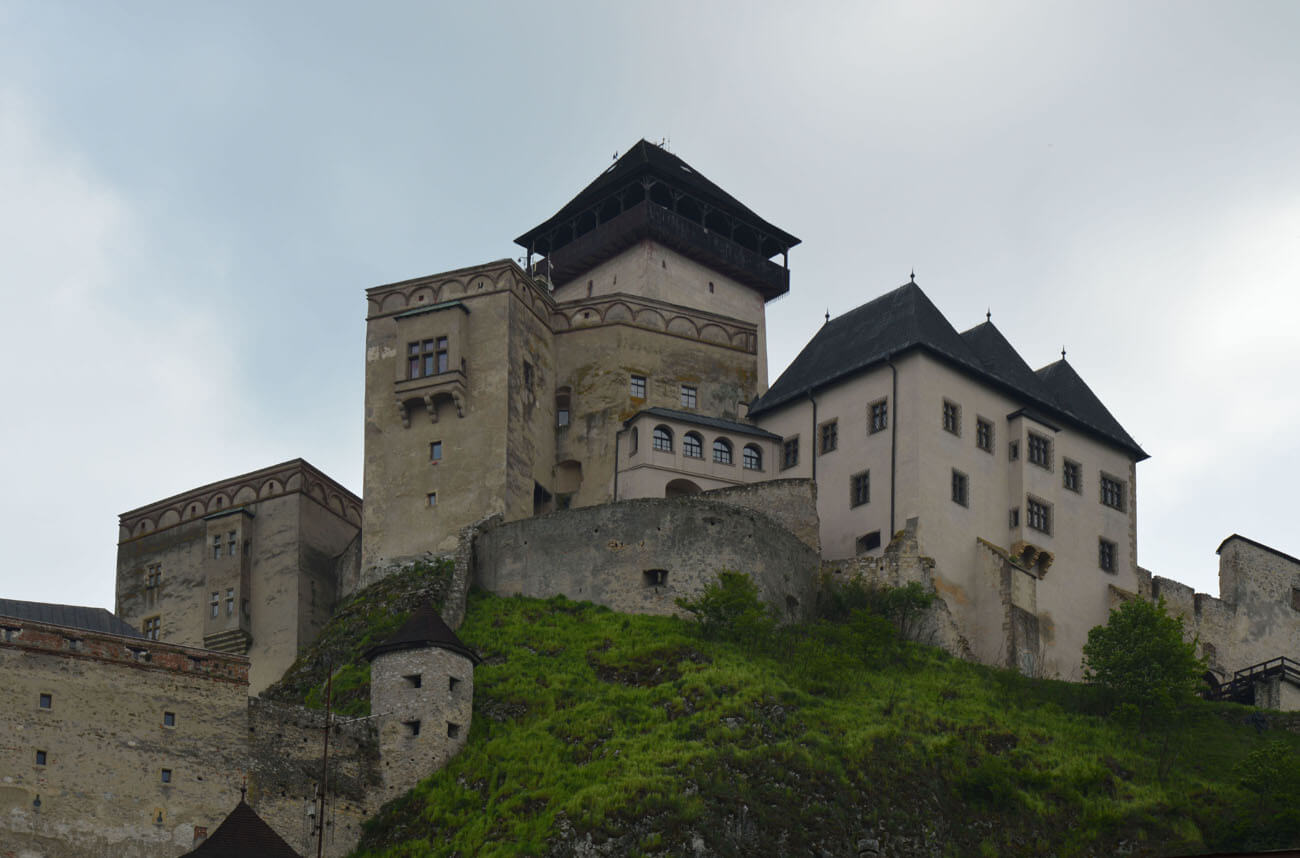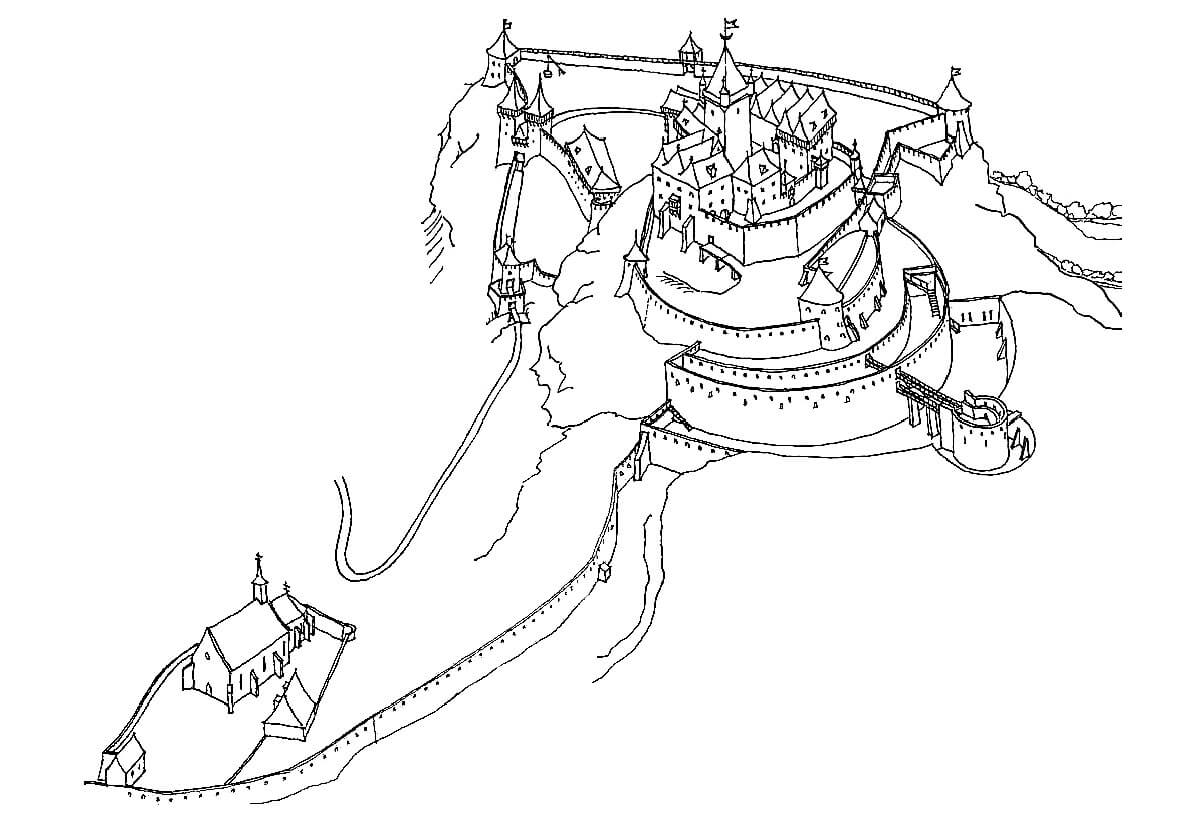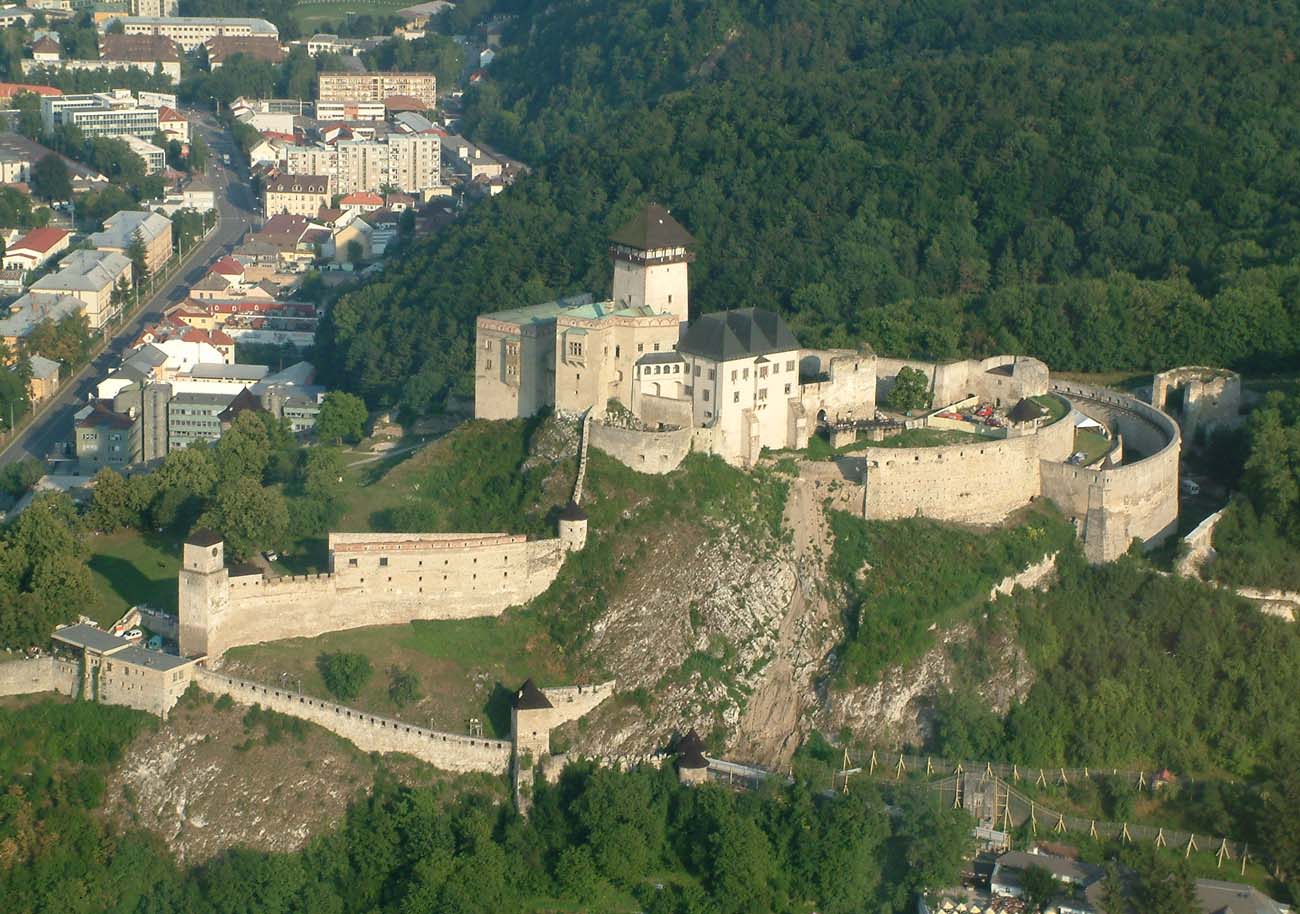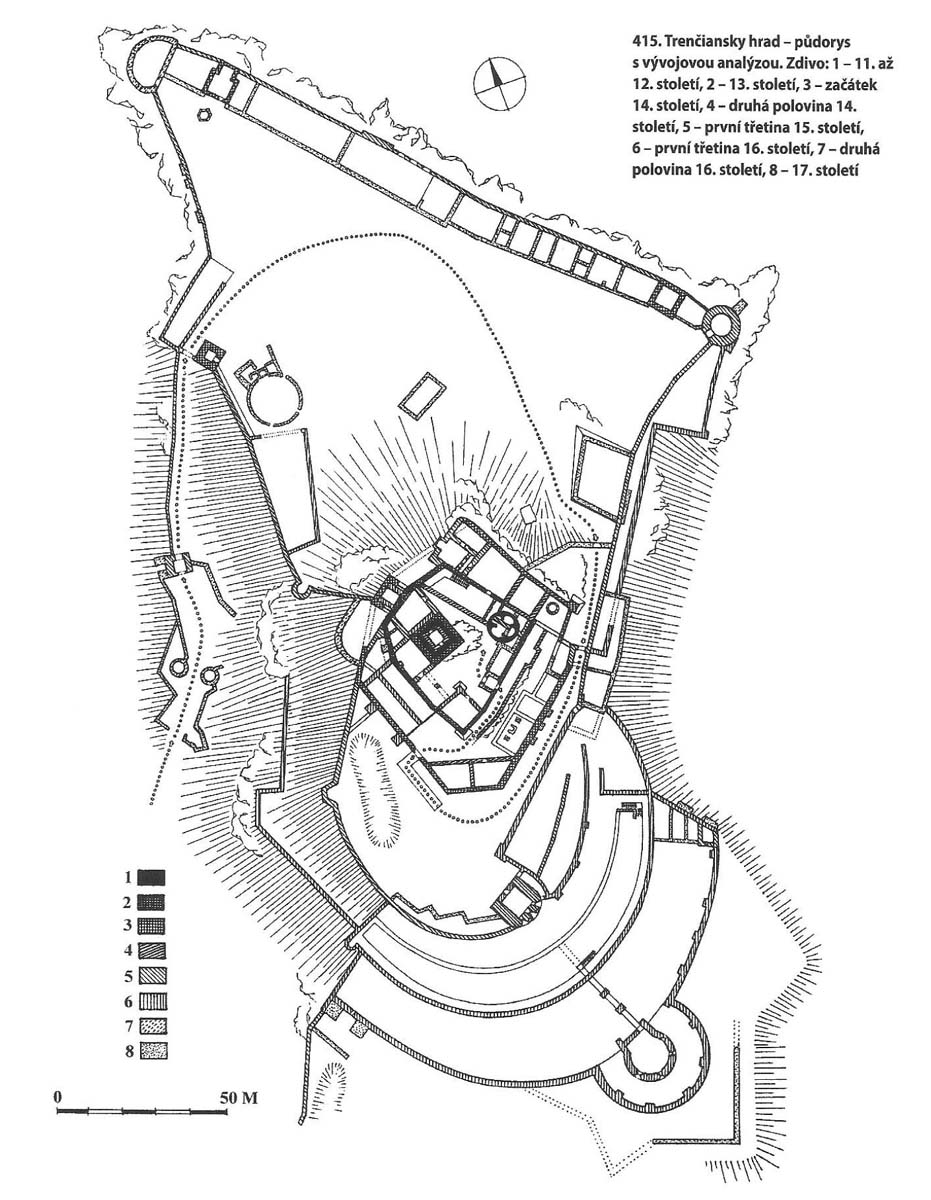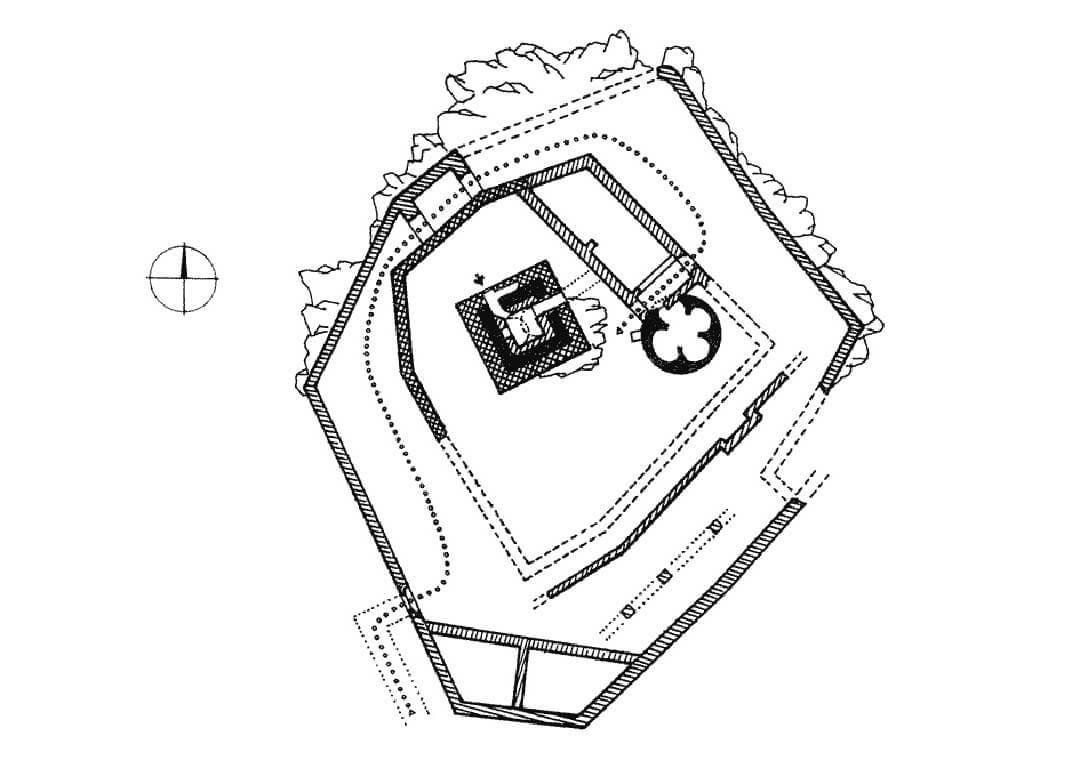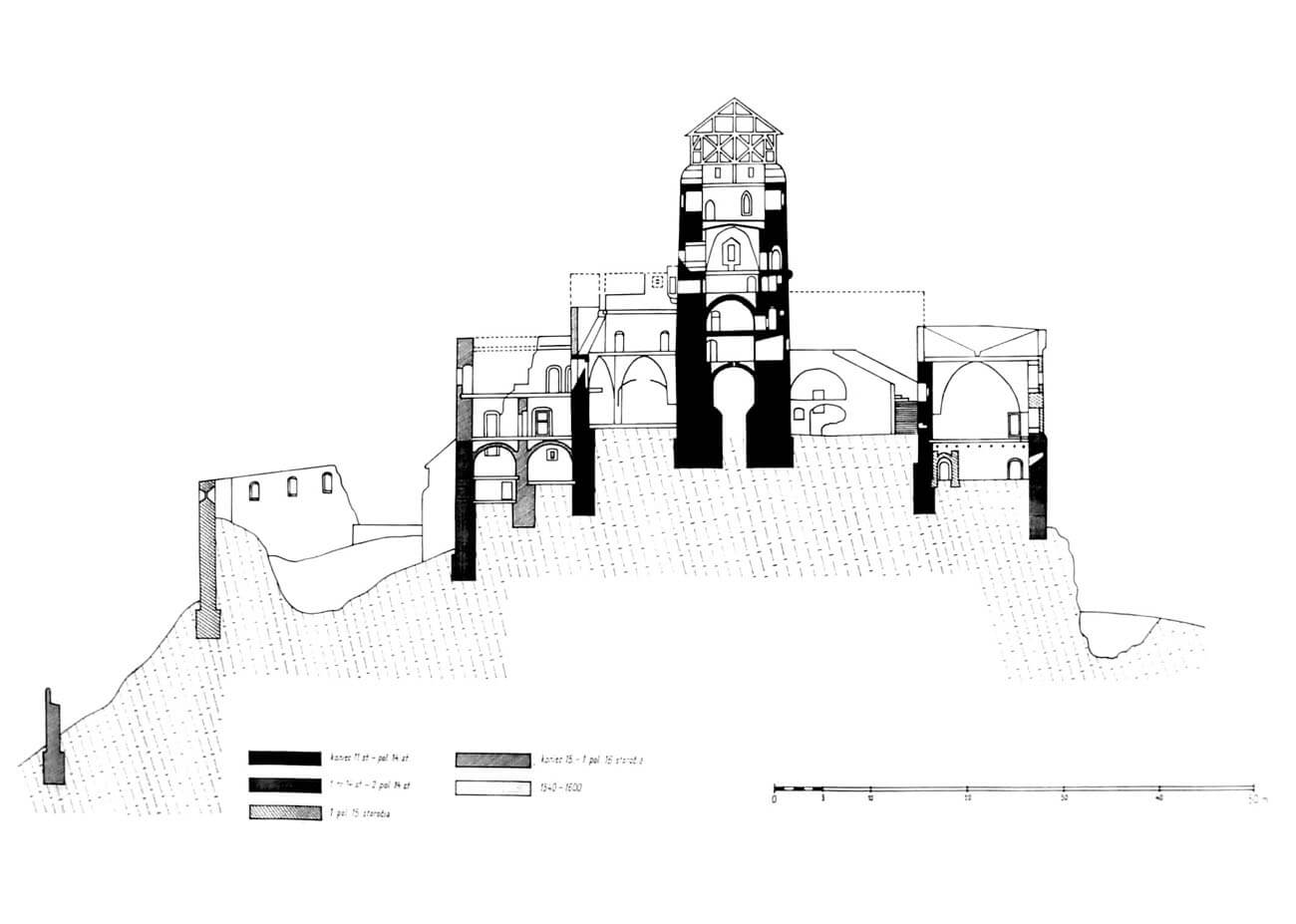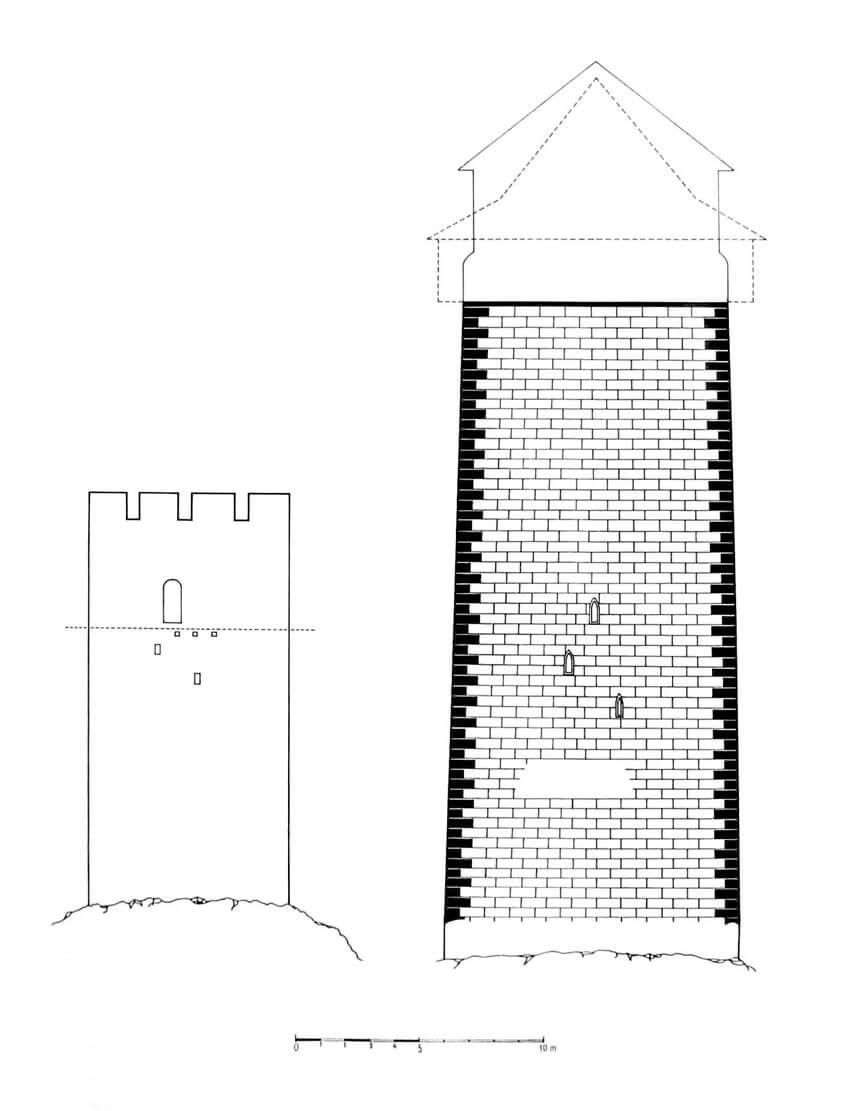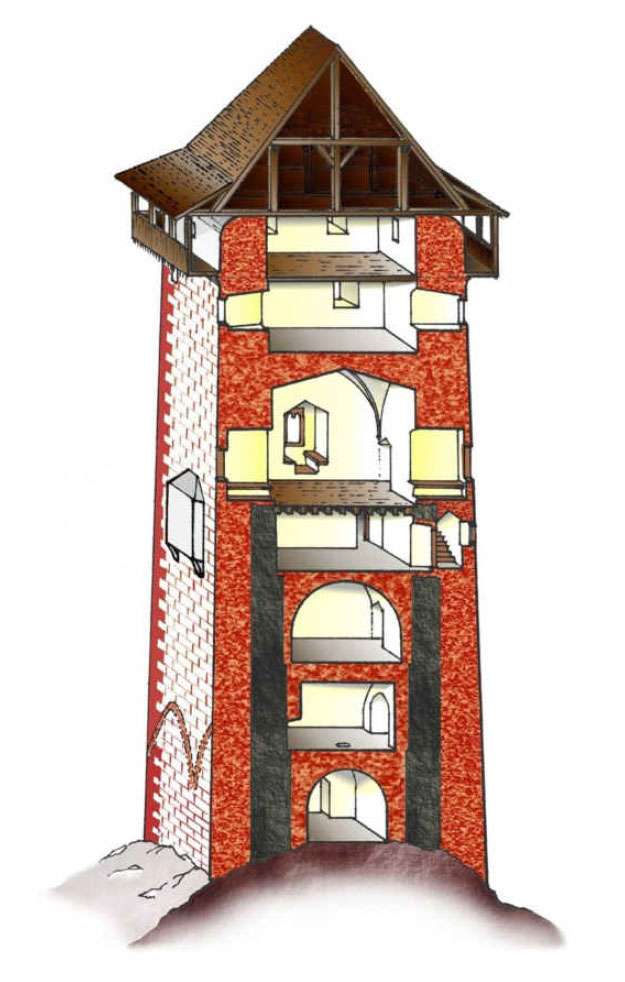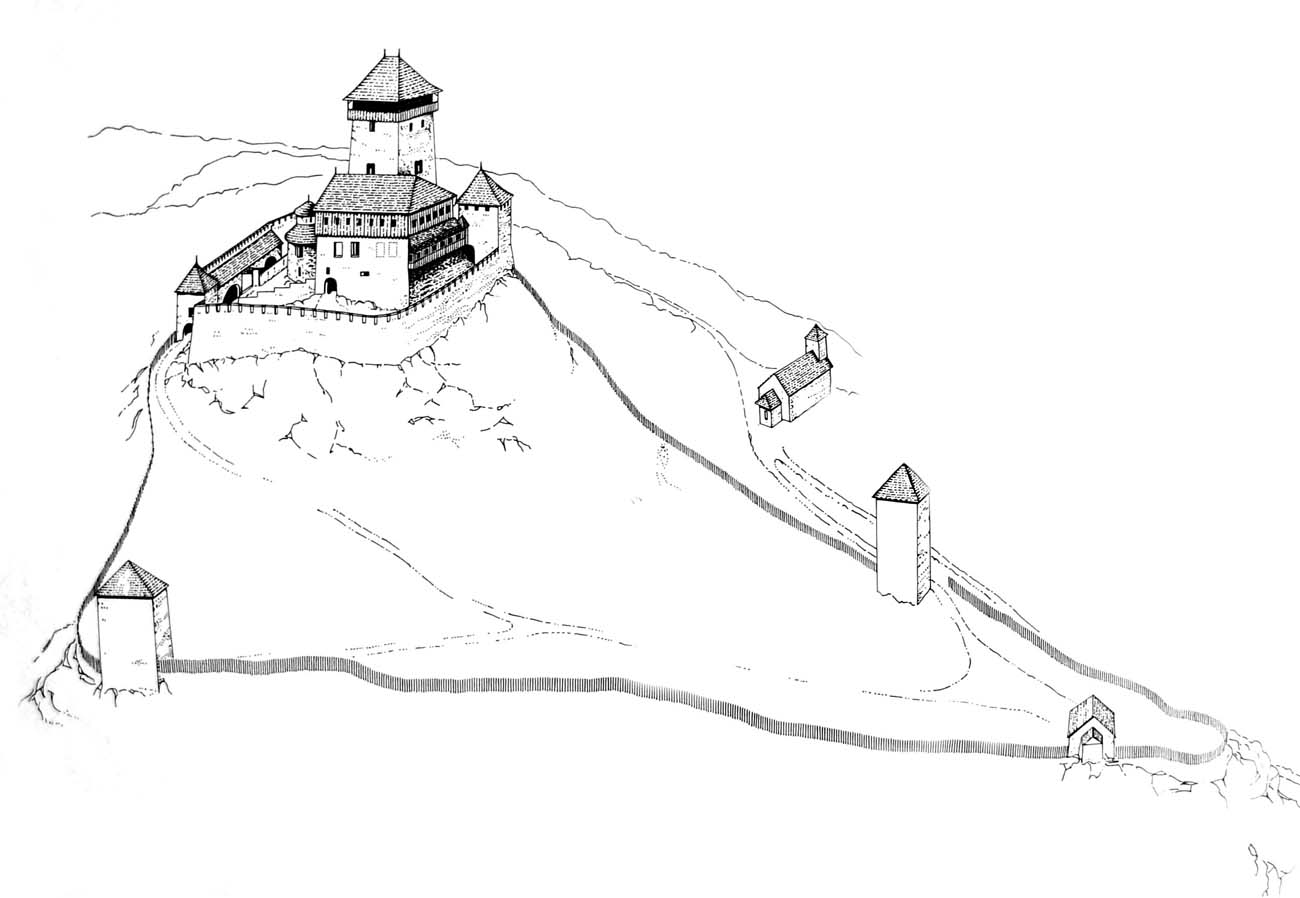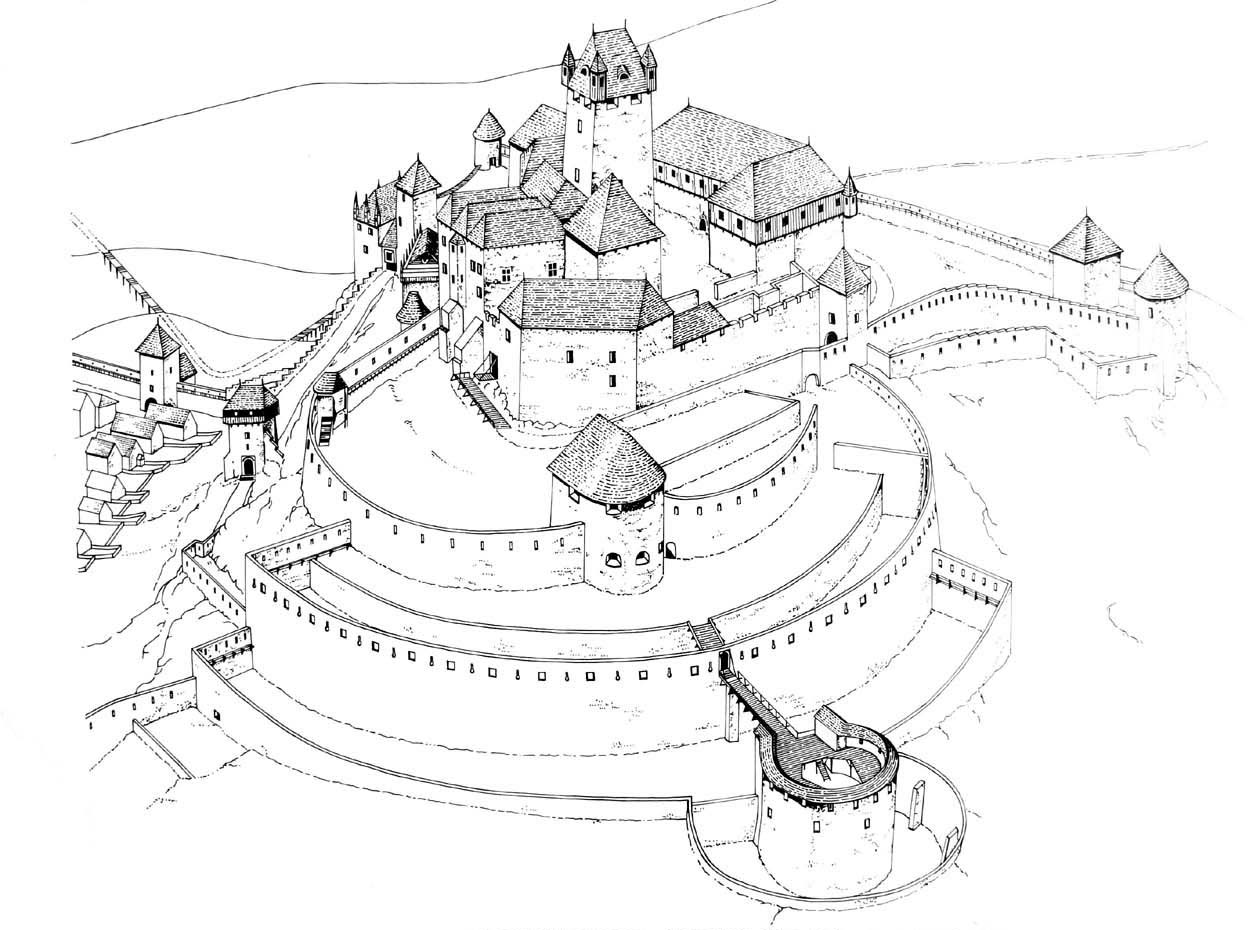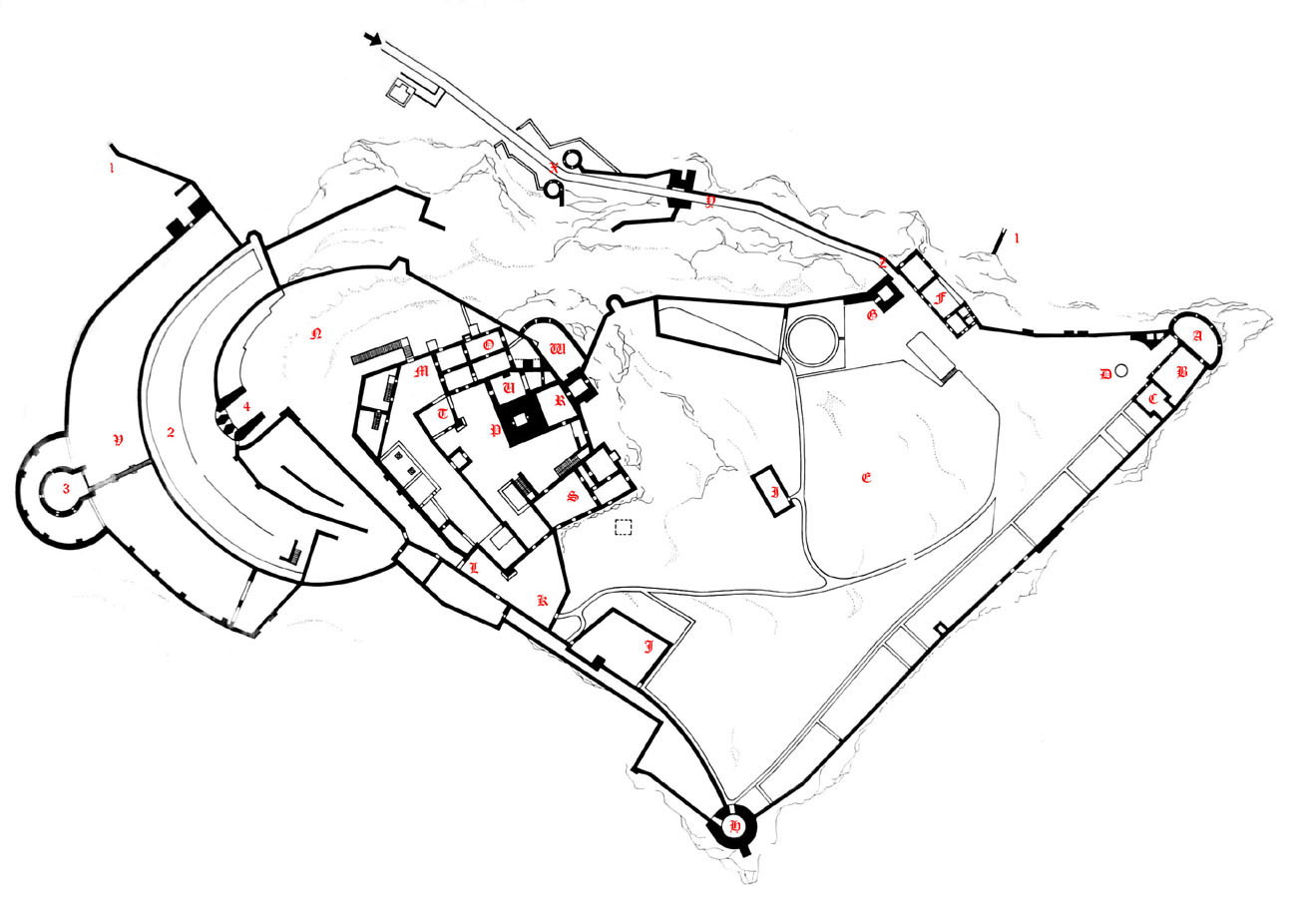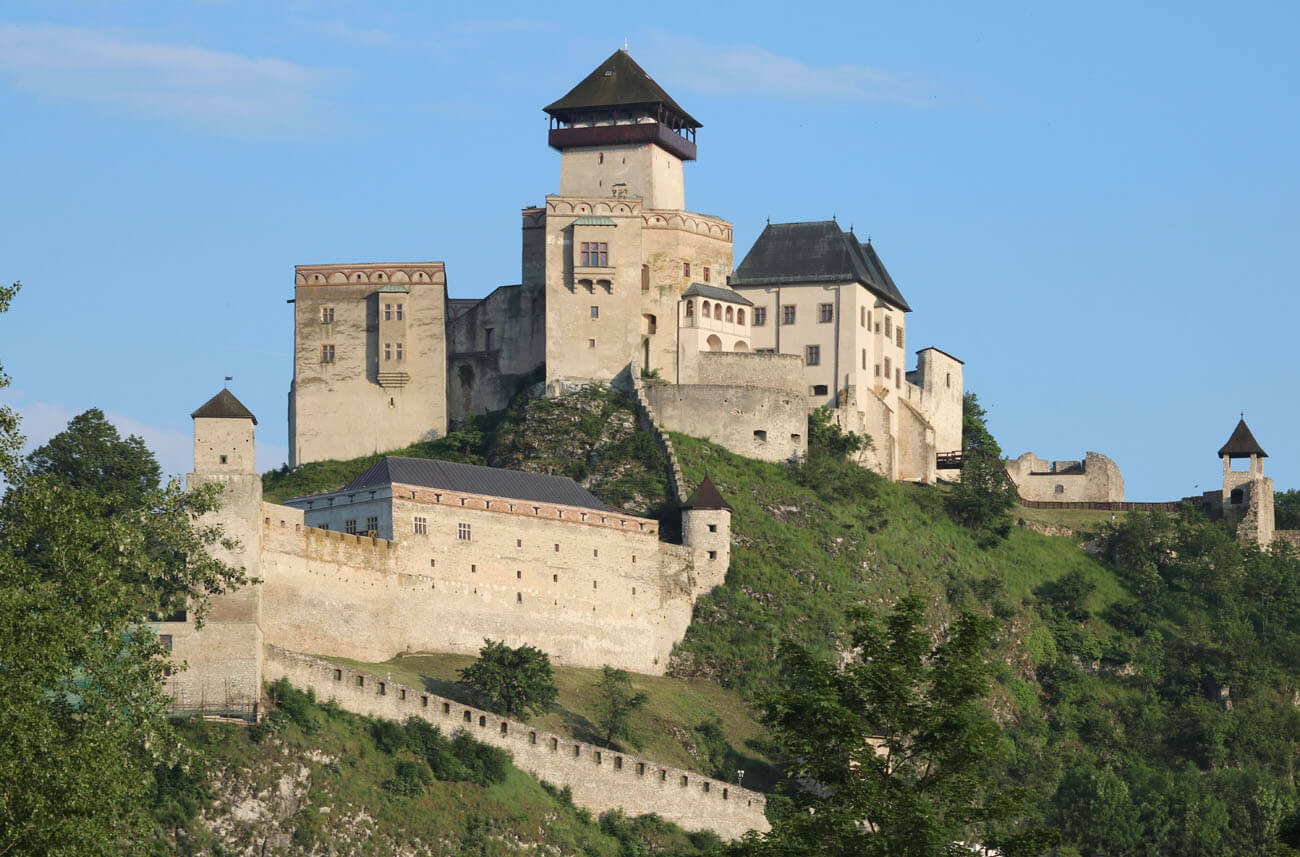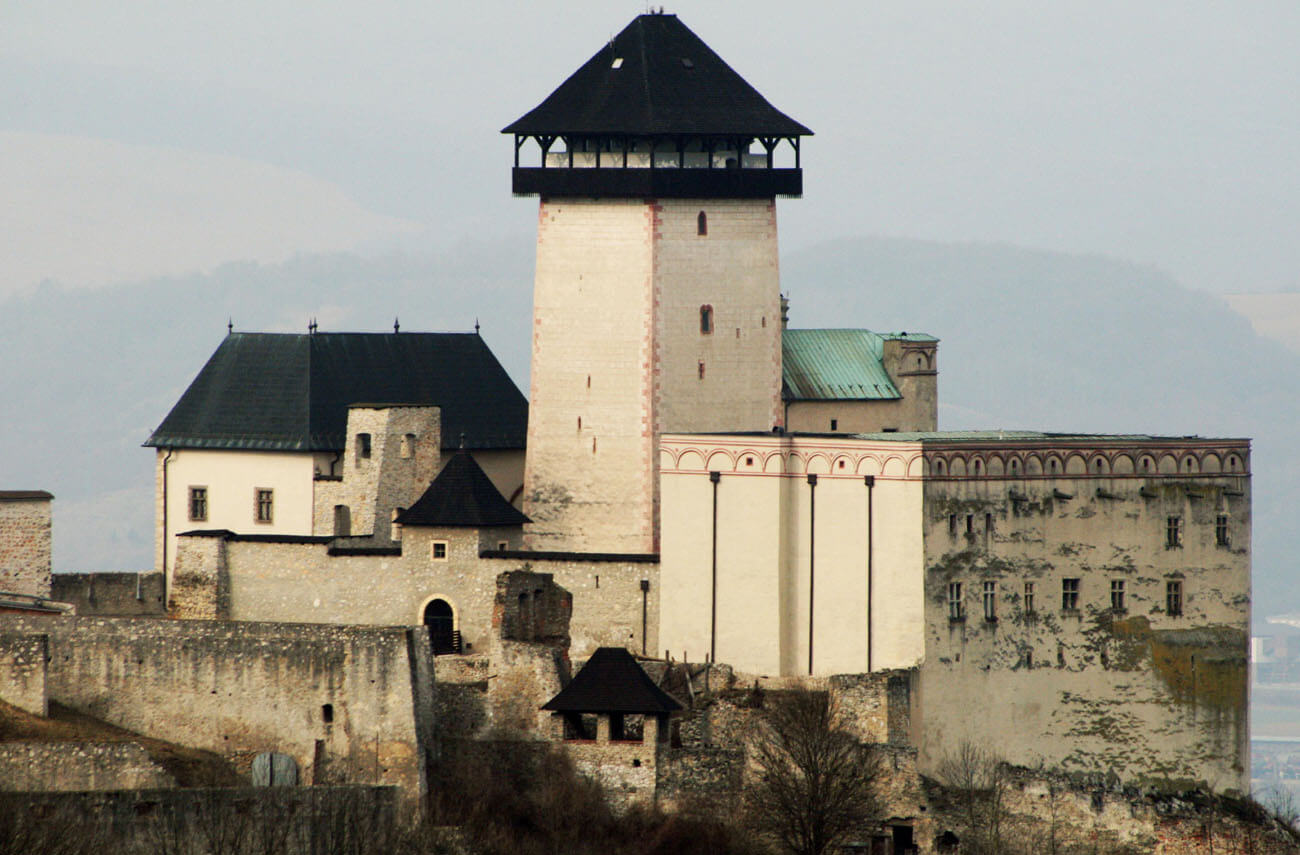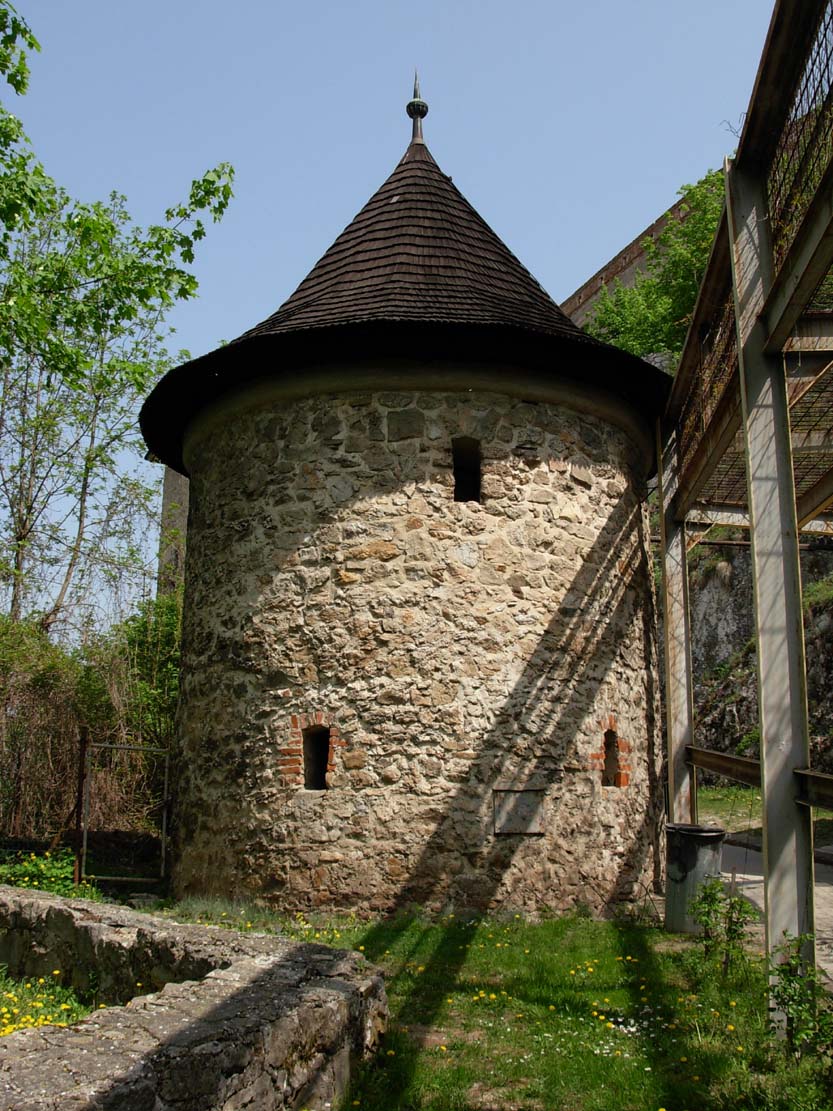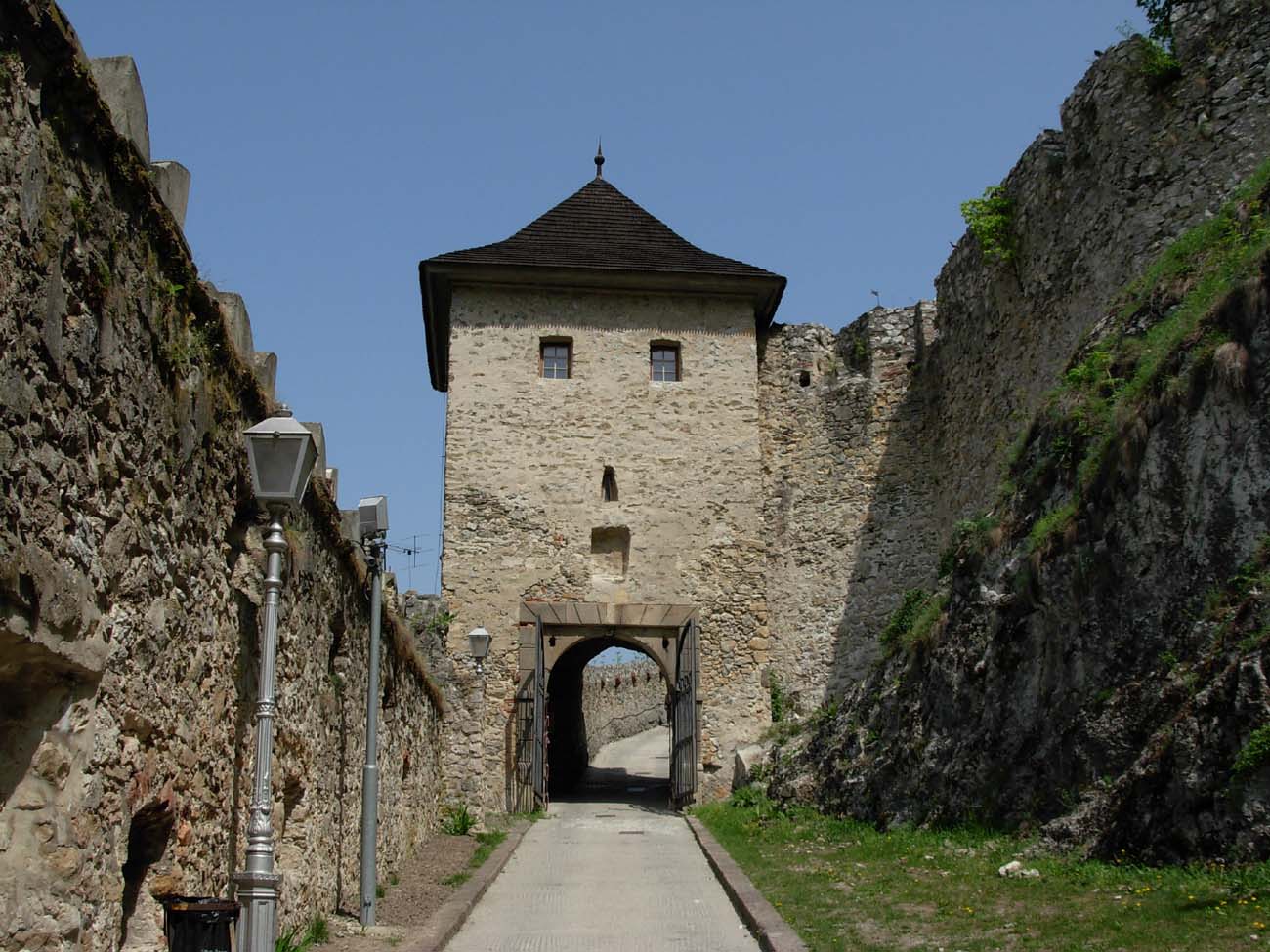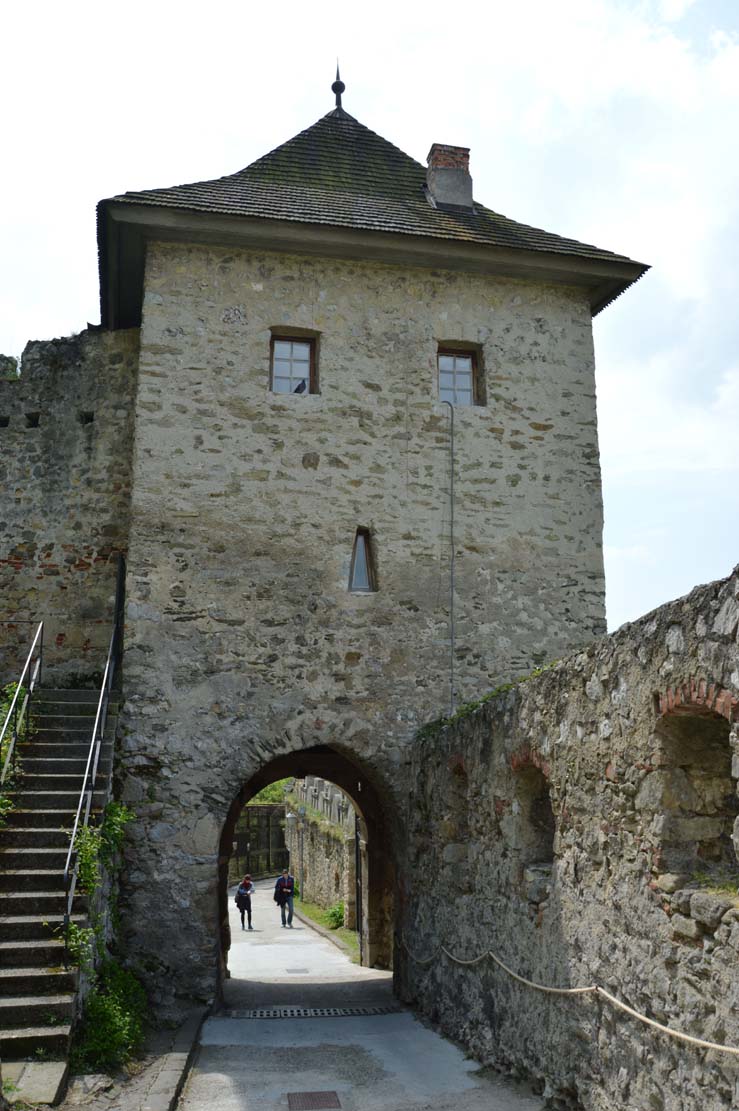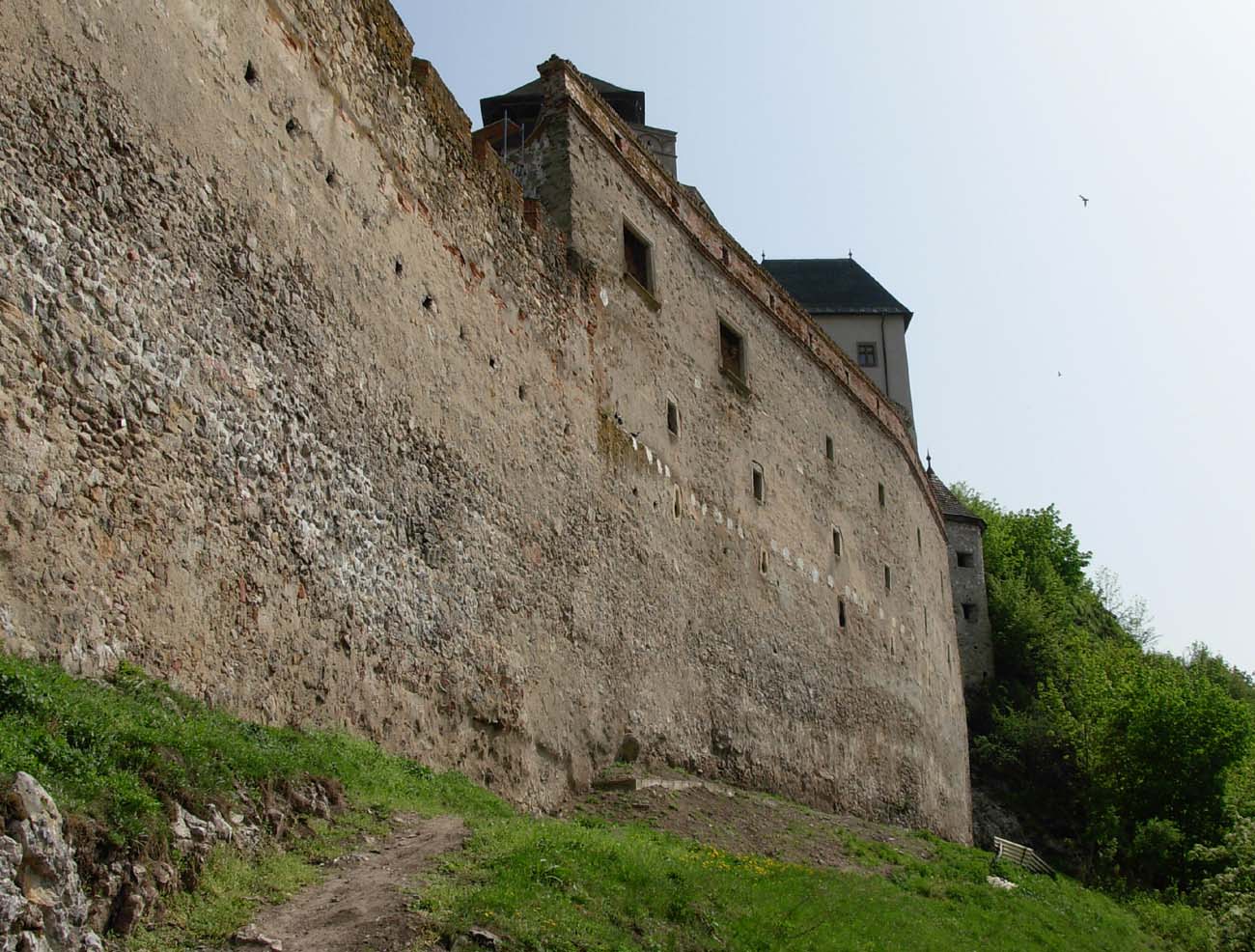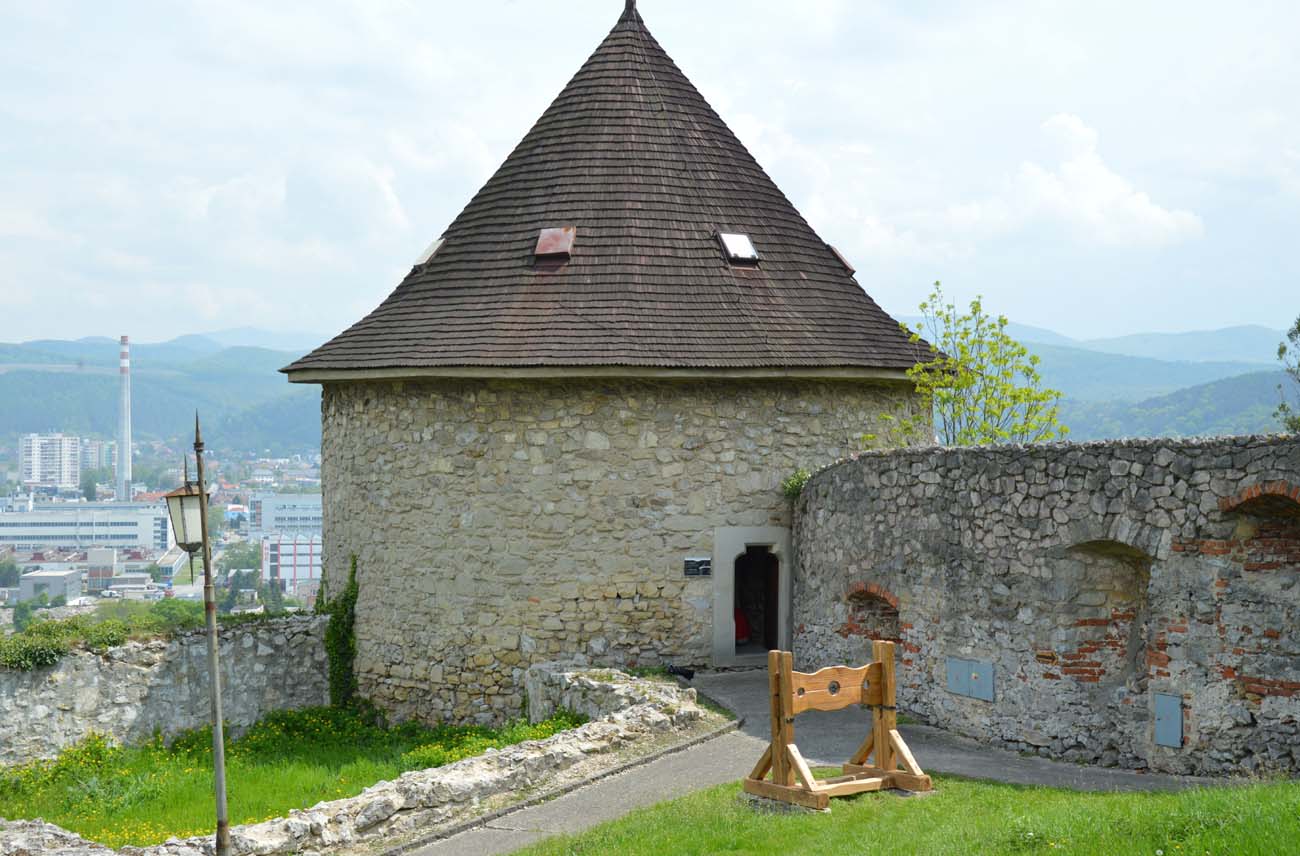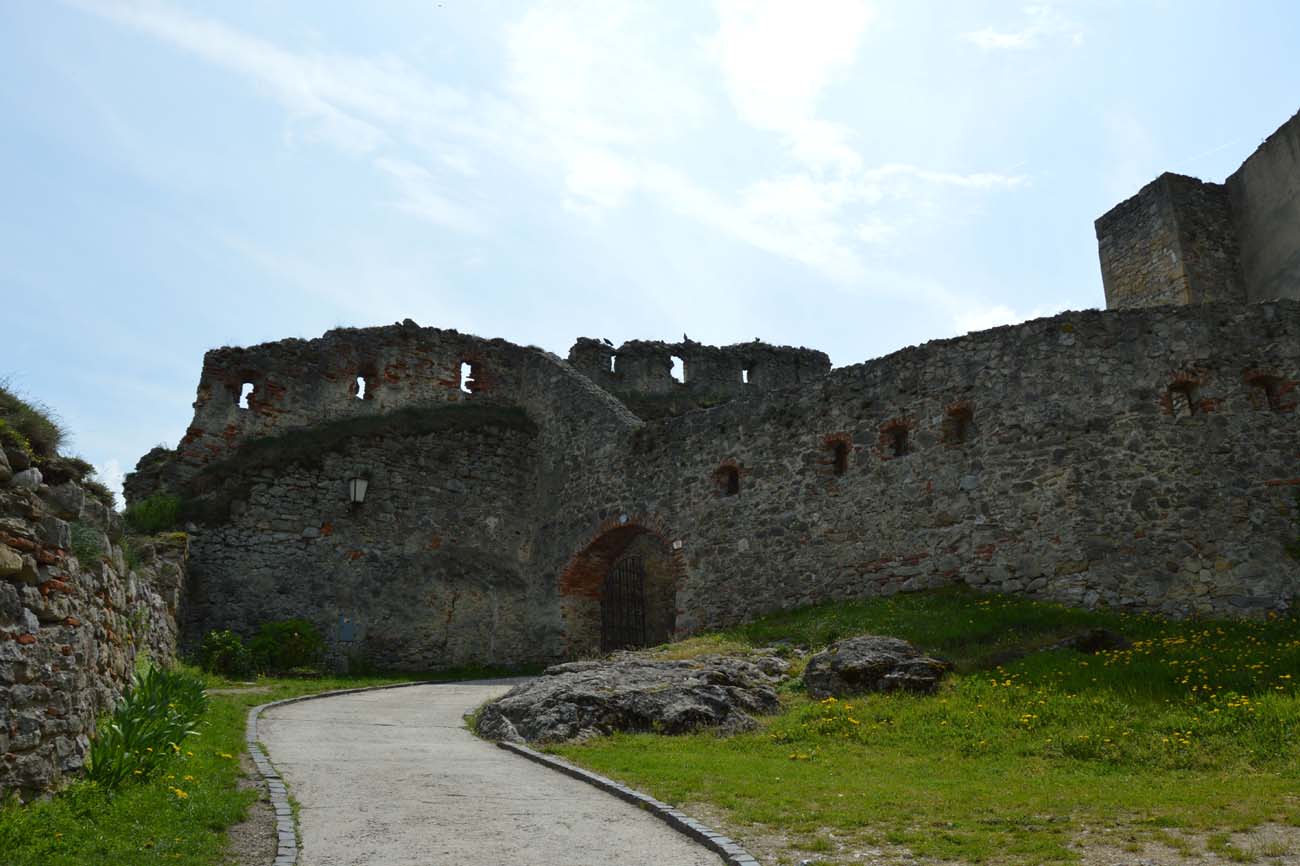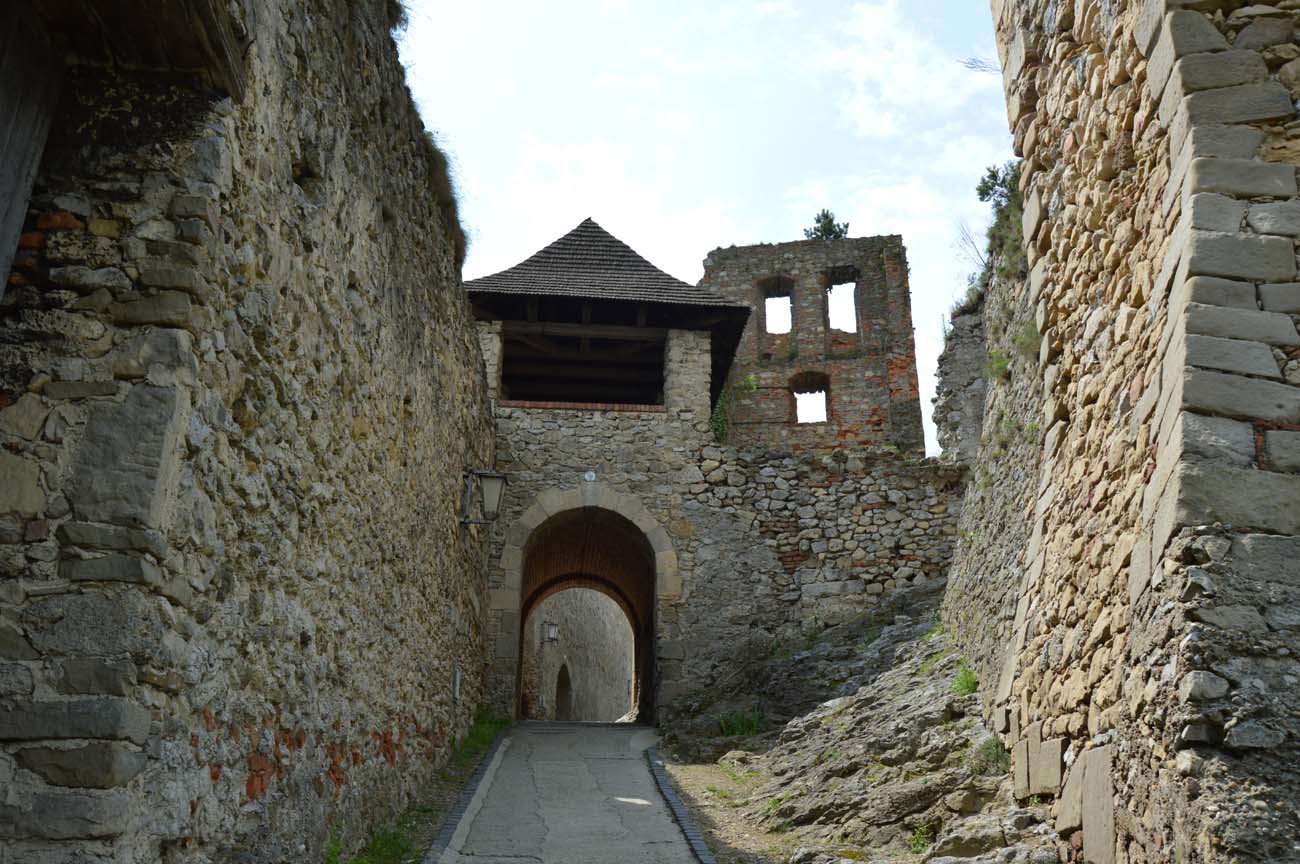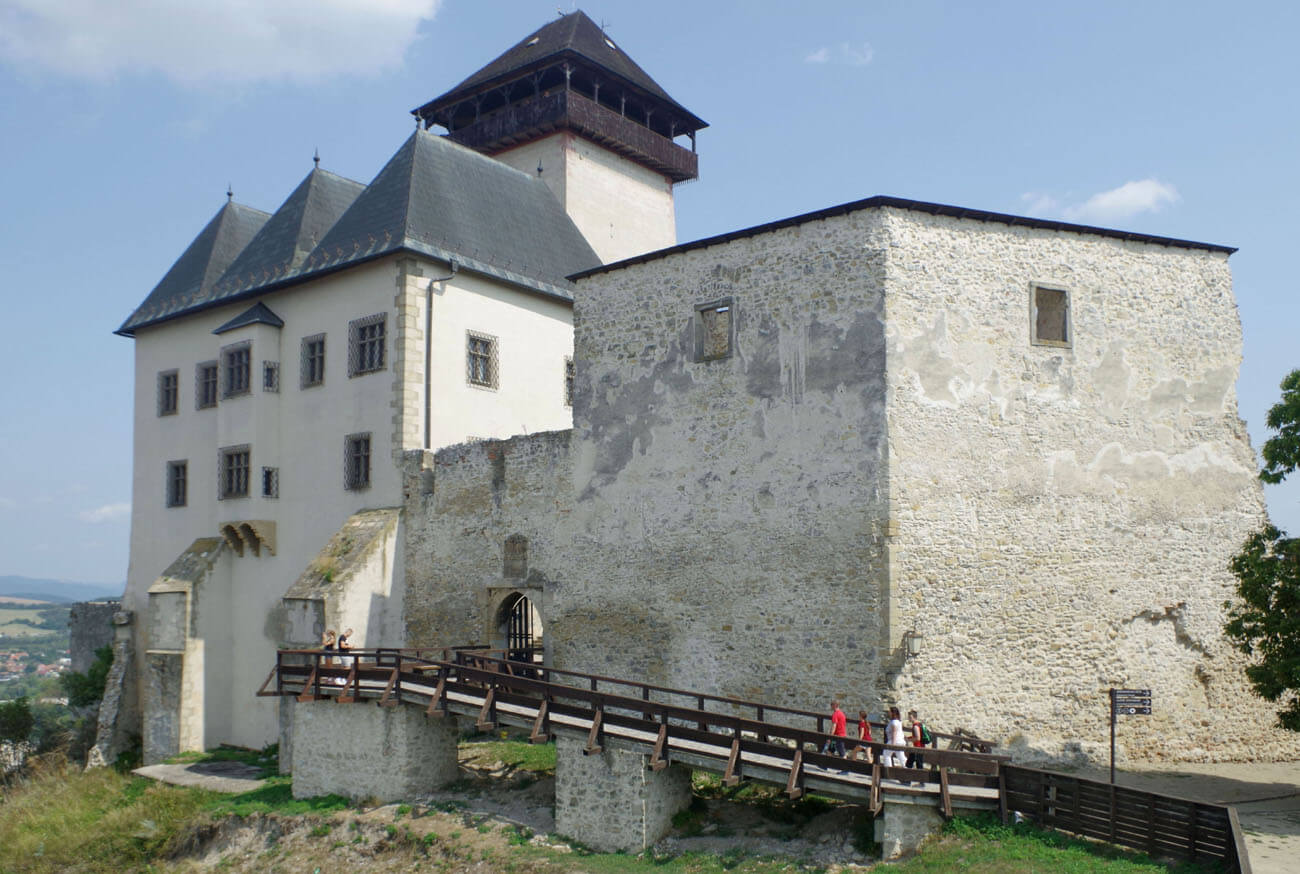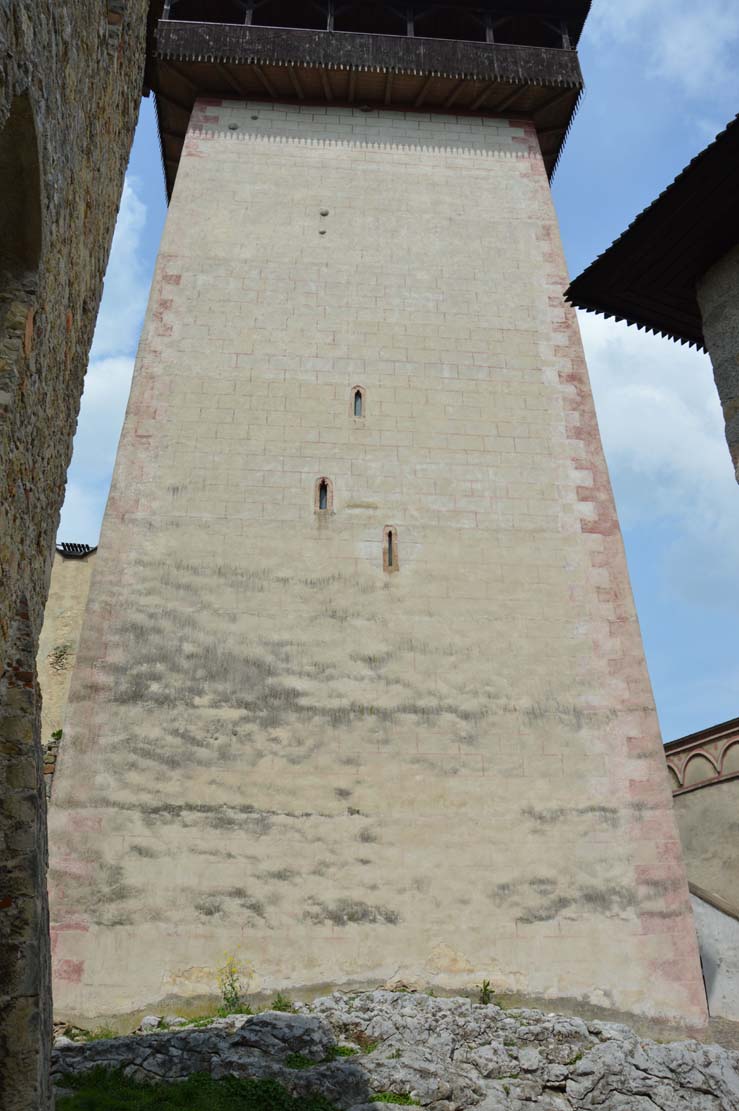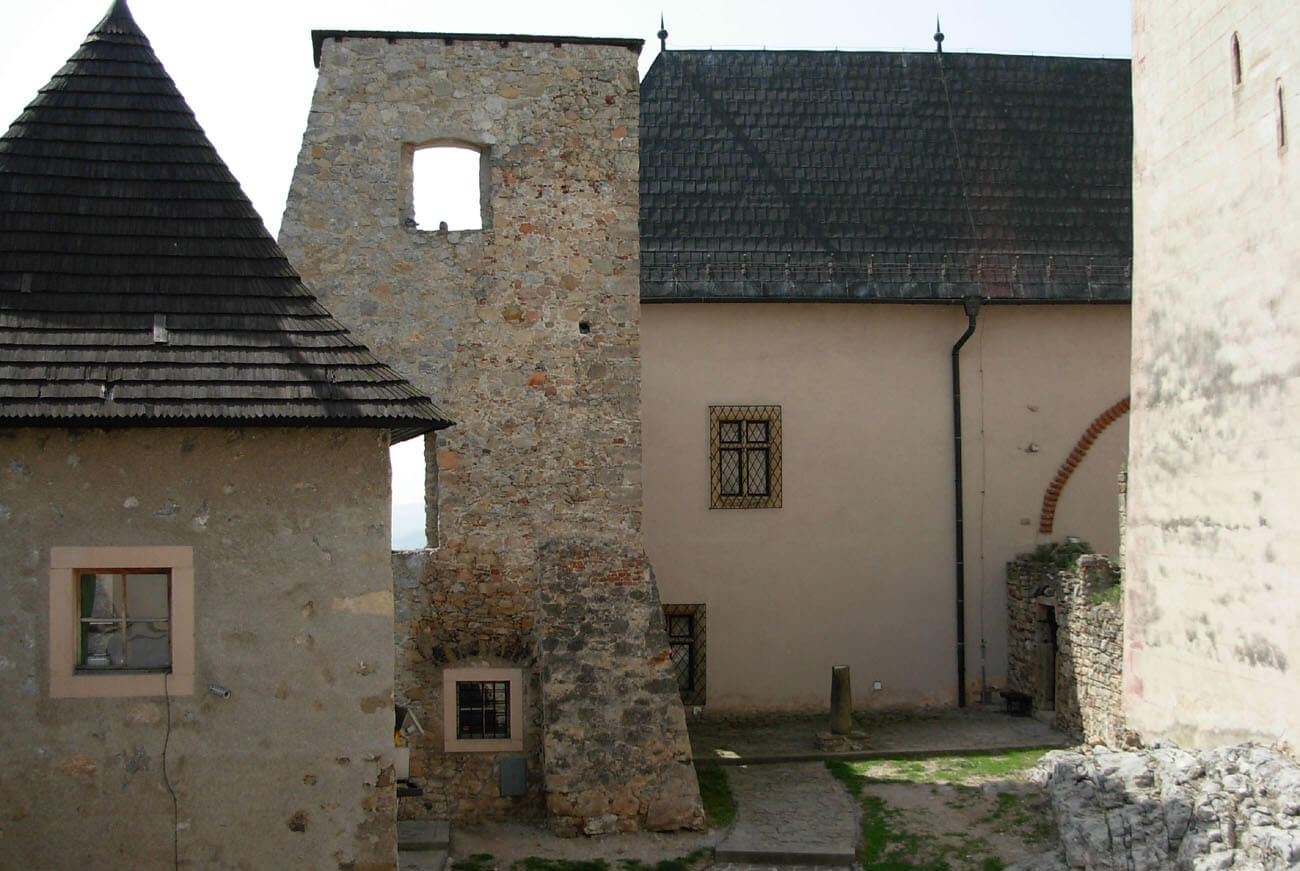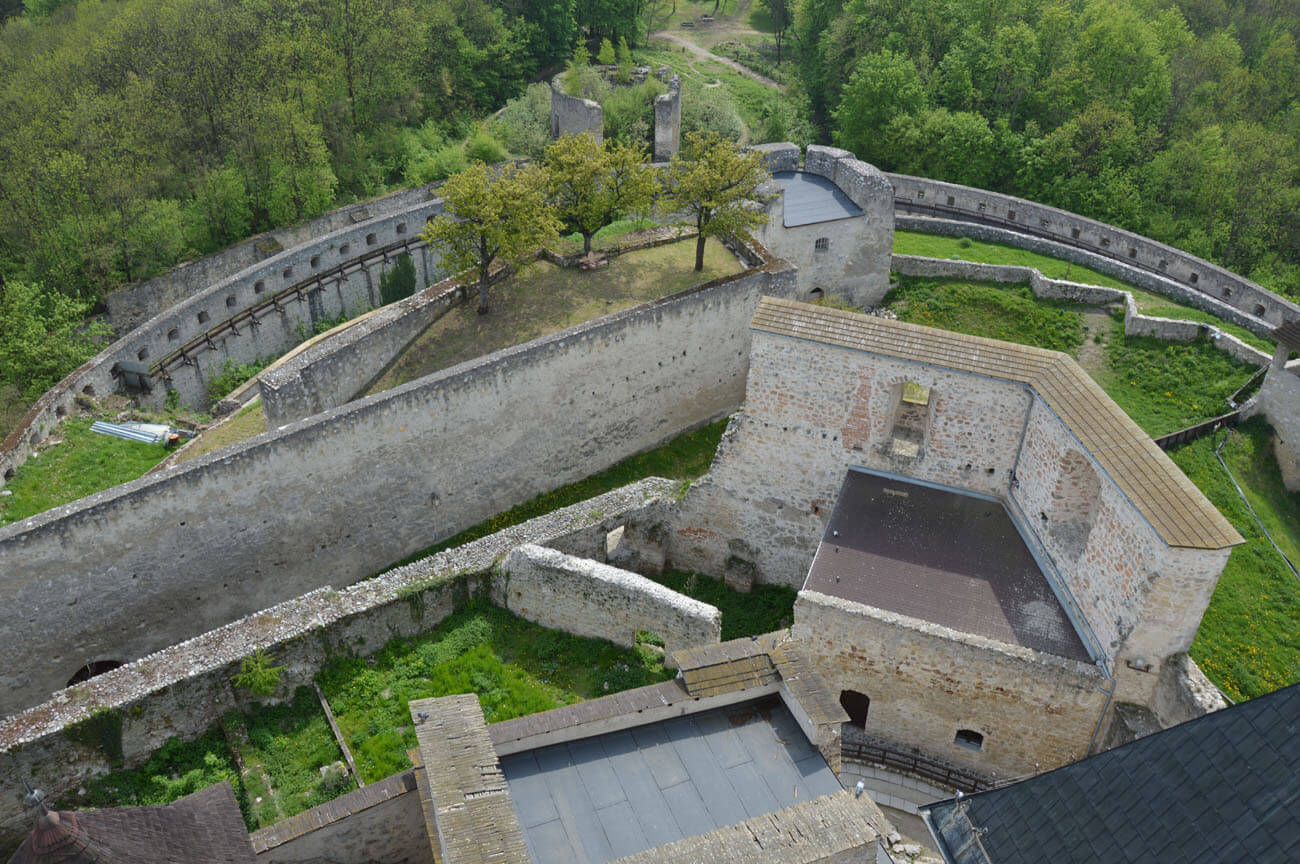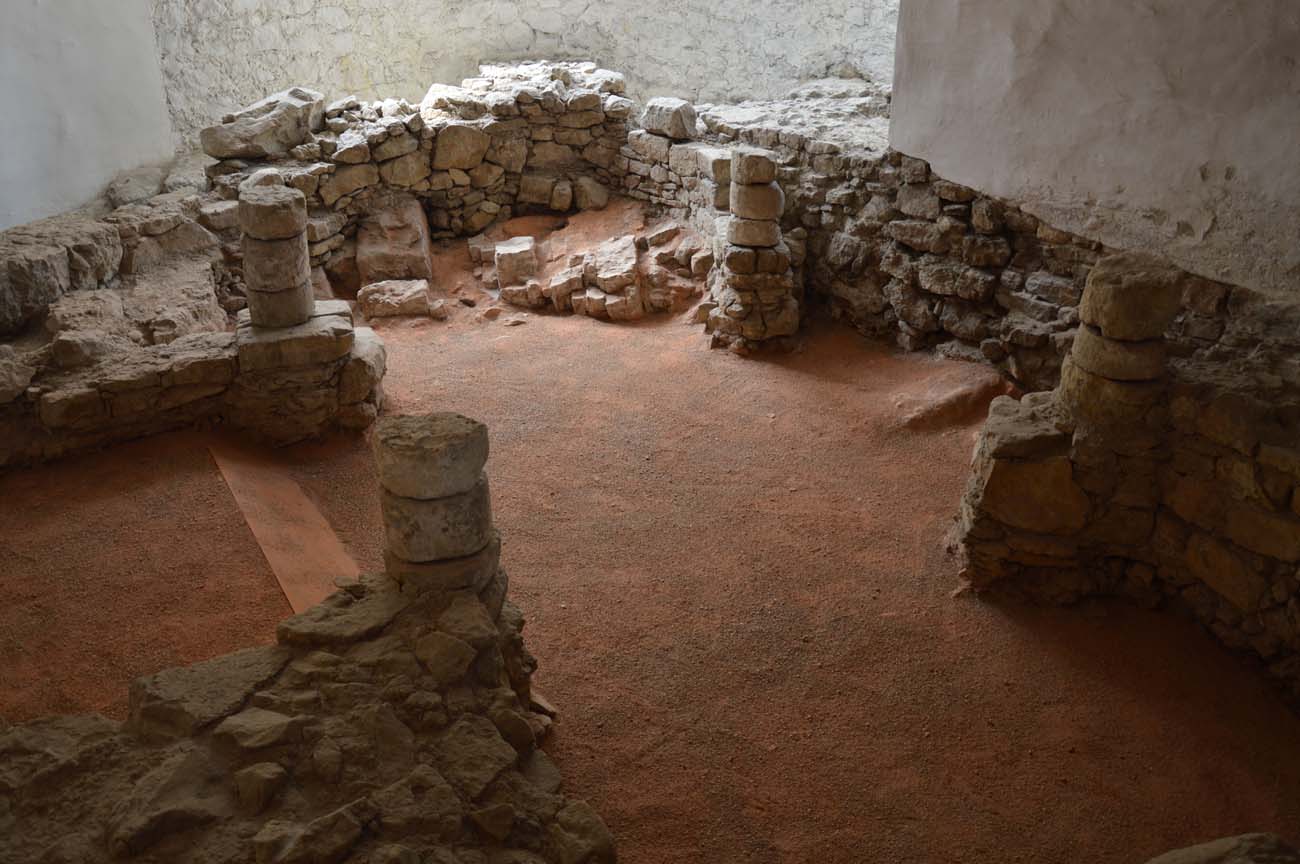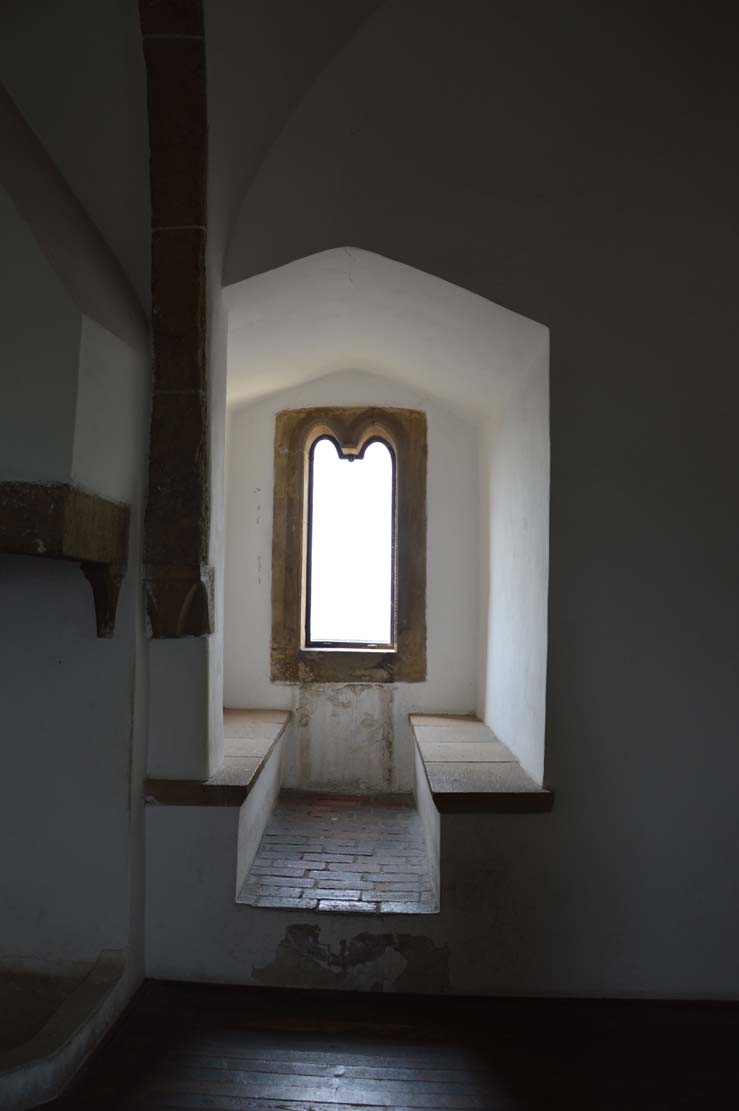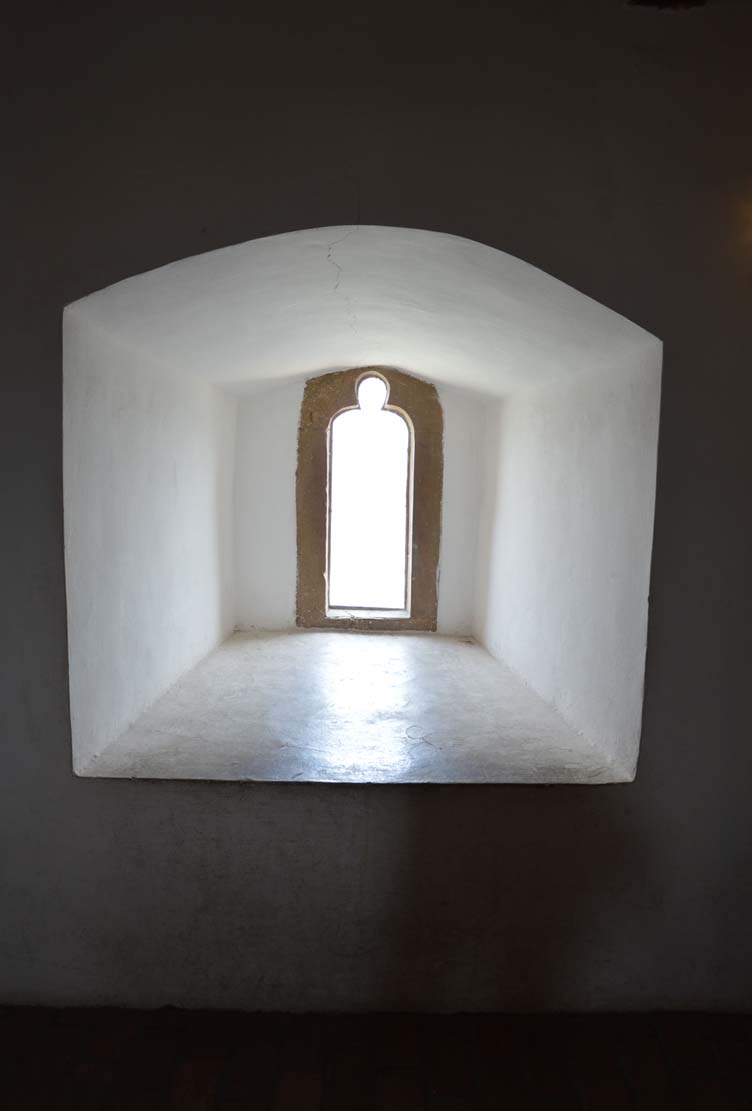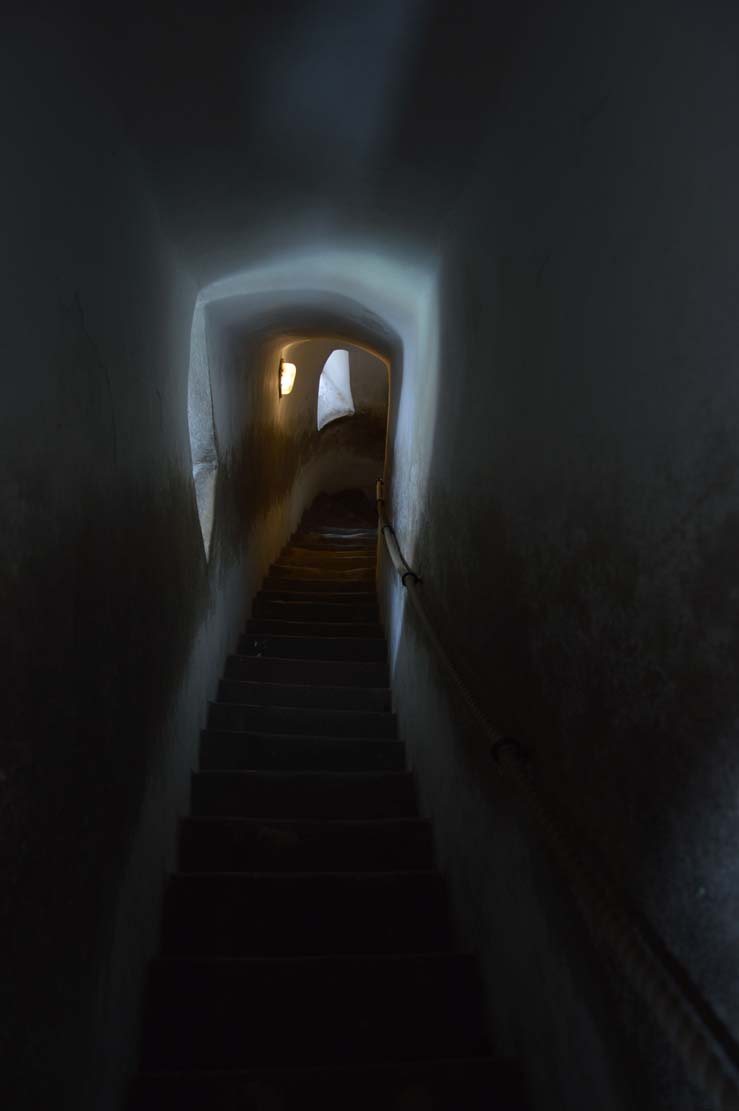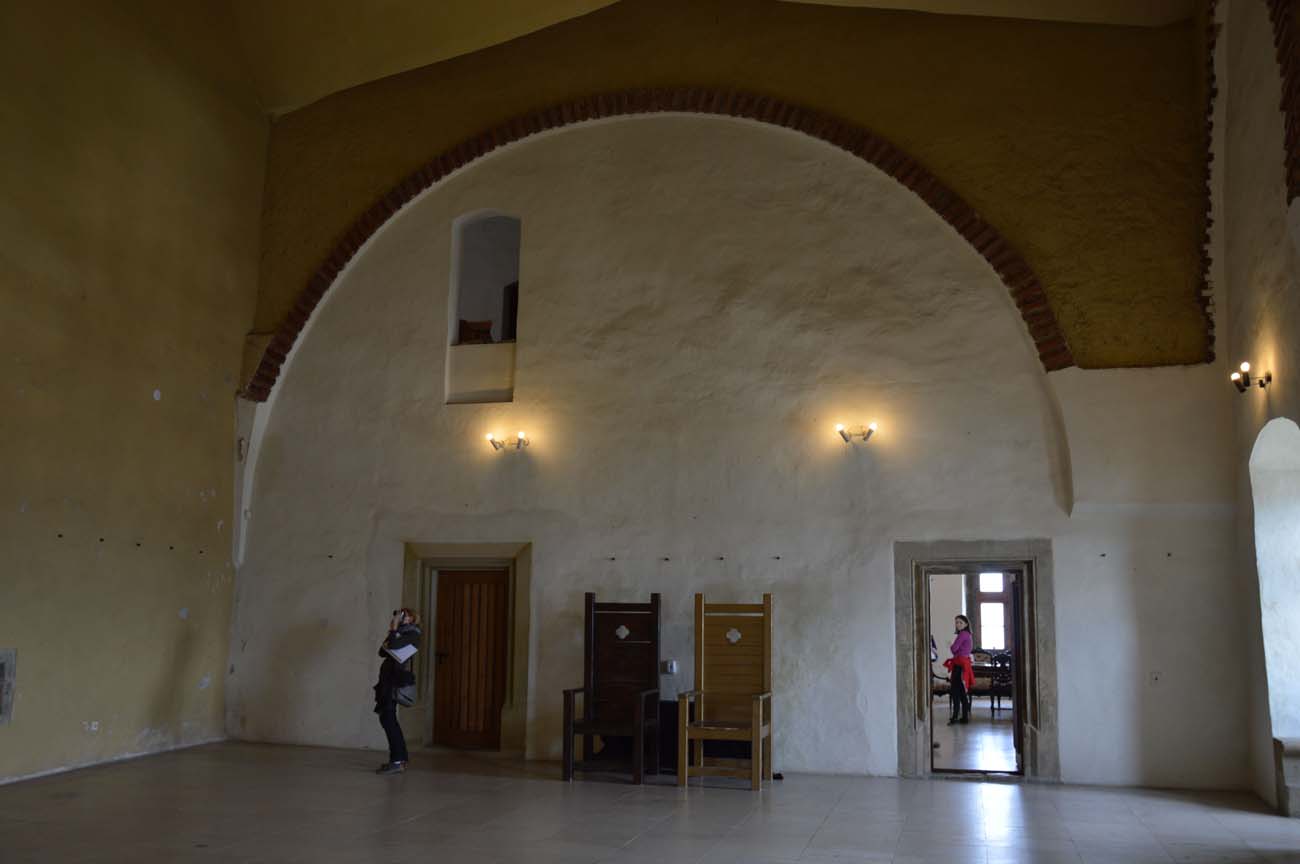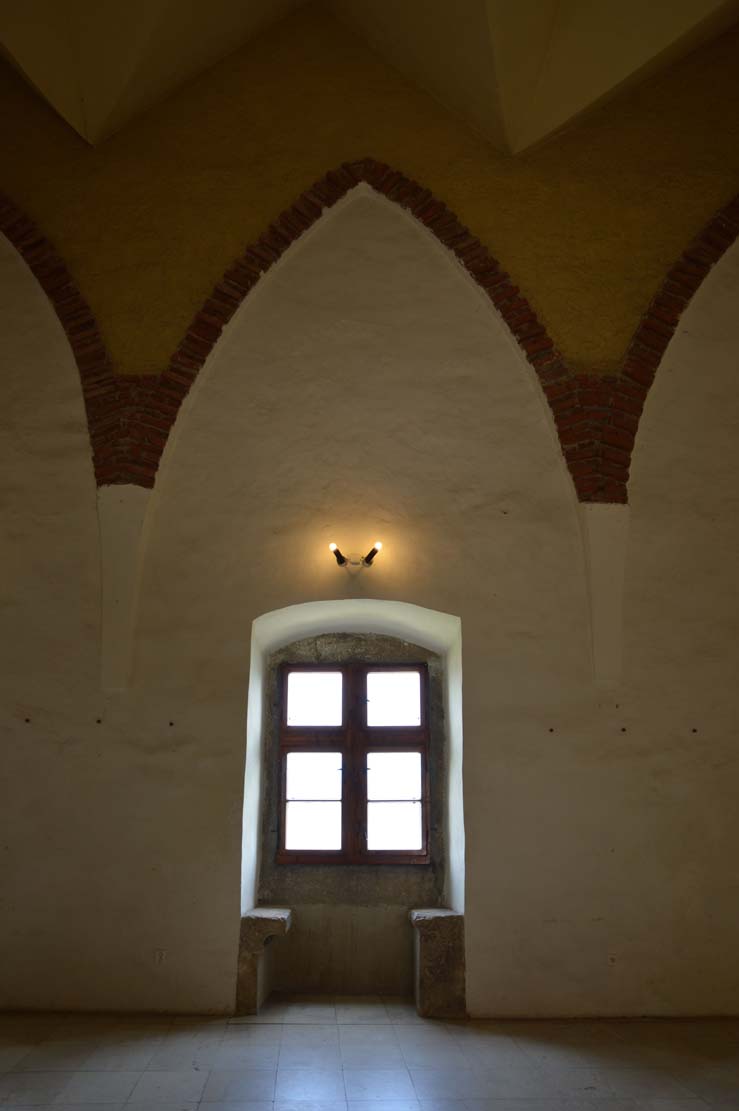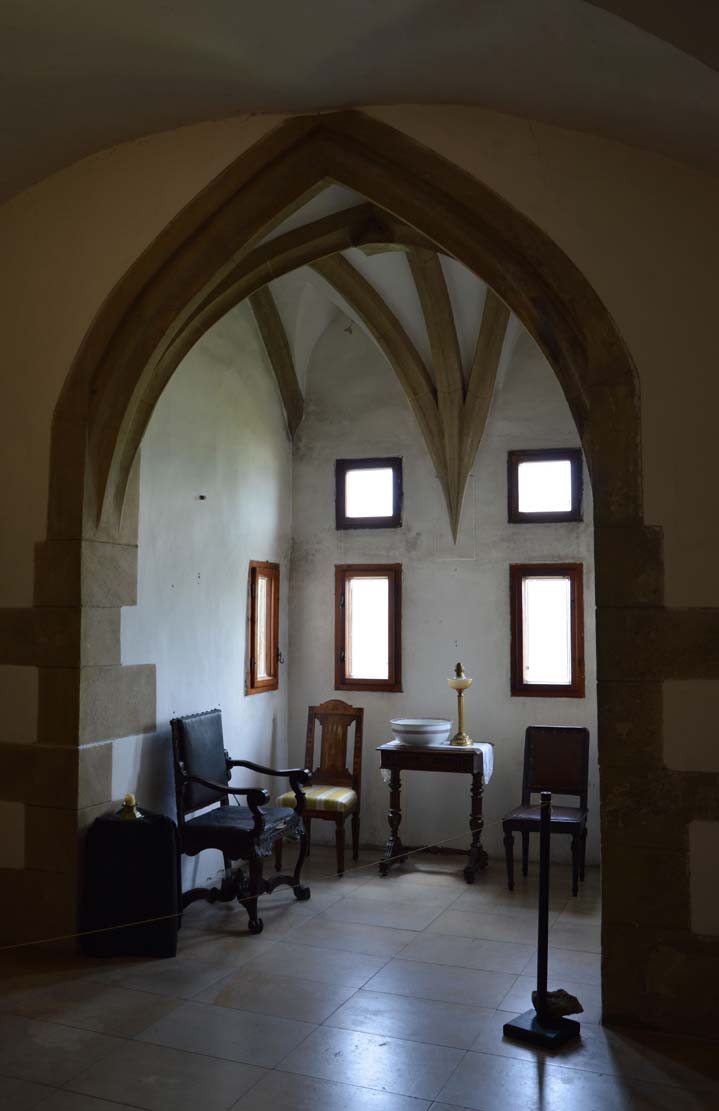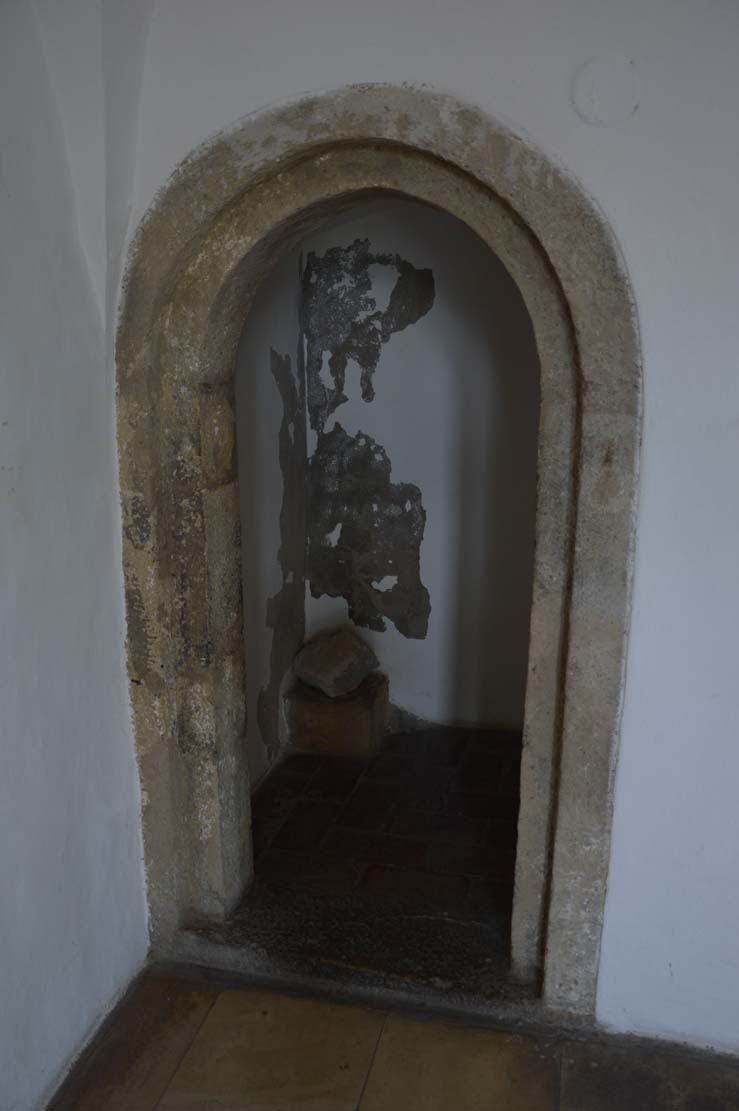History
The immediate vicinity of Trenčín was already inhabited in the middle and younger phases of the Paleolithic era, and the hill above the bend of the Váh River was inhabited by Celtic people in the Iron Age. In the Great Moravian period, the Slavs took advantage of the favourable terrain conditions to build a strong hillfort, on the site of which a stone rotunda was erected around the middle of the 11th century. A royal castle was also supposedly built in this period, which was among the oldest defensive structures in the Kingdom of Hungary, although initially it must have had only wood and earth fortifications. Its task was to protect the nearby state border, the trade route and the ford over the Váh. From the beginning, it was the seat of the Trenčín county, one of the oldest and most important in the whole of Hungary.
The first record of Trenčín was from 1067, but without indicating whether it referred to a settlement or, more likely, a castle. In the same year, the Czechs raided Trenčín, from where they took a large number of prisoners and cattle. The Hungarian King Salomon I, who owned the castle at the time, responded with a punitive expedition and, after plundering the vast territory of Moravia, returned to Hungary with many prisoners. Trenčín appeared in documents for the second time in 1091, when the Hungarian King Vladislav granted the nearby settlement of Banovy (probably Bánovce nad Bebravou) to Břetislav, the son of the Czech prince Vladislav. From the 12th century, the number of records of the castle began to increase: in 1193, “castrum de Trenchin”, in 1208 “castrum de Trincin”, in 1232 “castrum de Trencyn” or “castro Trynchyn”, and in 1302 “castrum et comitatum de Trynchzinio”.
In 1241, Trenčín Castle was one of the few to resist the Mongol invasion. Perhaps the castle’s buildings and fortifications were damaged during the fighting, or it was deemed necessary to further strengthen them, because after the middle of the 13th century a stone residential and defensive tower was built. It was probably built on the initiative of King Béla IV, who aimed to rebuild and improve the defensive capabilities of the royal castles as part of the consolidation and reconstruction of the country destroyed by the invasion. In 1275, Štefan Čák (István Csák) became the Trenčín zupan. His family quickly gained importance in the second half of the 13th century. In 1296, Štefan’s nephew, Matúš Čák (Máté Csák), received the office of palatine of Hungary and chose Trenčín as his main seat. The Čák family became hereditarily linked to it, which contributed to the expansion and strengthening of the castle, as well as to making it the centre of an extensive domain (“terra Matthei”), thanks to which Matúš could compete with the Hungarian King Charles Robert at the beginning of the 14th century.
In 1321, after the death of Matúš Čák, the castle was captured by the troops of King Charles Robert after a long siege and remained in the hands of Hungarian rulers for the next century and a half. During the reign of Louis I the Great, another rebuilding began, which was completed at the beginning of the 15th century by his successor, Sigismund of Luxembourg. At the turn of the 1420s and 1430s of the 15th century, the castle withstood several sieges by the Hussites, although during one of their expeditions they plundered the town. In 1475, Trenčín passed into the hands of Stefan Zápolya, and in 1493 it became the hereditary property of this family and remained with them until 1527. During these more than fifty years, another major rebuilding of the castle took place, focused primarily on improving its defences, in connection with the intensive development of firearms. As a result, Trenčín Castle became one of the best protected and at the same time the most impressive residences in the northern part of the kingdom.
During the fights for the Hungarian throne between Ferdinand Habsburg and Jan Zápolya, Trenčín was besieged by imperial troops under the command of General Katzianer in 1528. Long artillery fire caused numerous fires and ultimately led to the castle’s capitulation. The castle walls suffered severe damage, but were quickly repaired, and in the years 1535-1540 were strengthened and modernized under the supervision of imperial engineers, although no significant changes were made to the layout of the defense system. The work was then supervised by the new owner of Trenčín, Elek Thurzo. Further reconstructions of the fortifications and residential buildings, this time in the Renaissance style, were funded in the years 1583-1592 by Imre Forgách. In 1596, the castle was taken by the llśshśzy family, whose representatives adapted the interiors and exteriors of the buildings to changing tastes in the period 1610-1468.
During the 17th-century wars, the castle fortunately did not experience a siege by the Turks, although small raiding parties ventured near Trenčín, and in 1663 the entire Turks was already in Nitra, 70 kilometres away. Due to the Turkish threat, the llśshśzy family asked the emperor to reinforce the garrison. The strong German garrison that arrived in Trenčín in 1670 built the earthen ramparts in front of the castle, but also became a real nuisance for the town. The residents had to support them and meet increasingly exorbitant demands, also requisitions and robberies were commonplace. The most effective form of persuasion was shelling the town. The soldiers were not defeated by either Thokóly’s rebels or by Rákóczi’s troops during the anti-Habsburg uprisings. The imperial garrison remained in Trenčín until 1782, after which the llśshśzys returned to their neglected estate. Plans for a general renovation of the castle were thwarted by a major fire in 1790. From then on, the condition of the building slowly deteriorated, although many minor renovations were carried out until the mid-19th century. The general, long-term reconstruction did not begin until 1956.
Architecture
The stronghold and later the castle were built on a promontory of a hill, towering over the valley and jutting into the bend of the Váh River, which flowed on the north and west sides. The steep and rocky slopes provided protection on three sides, namely from the west, north and east, while it sloped down more gently to the south, where they connected with the rest of the Brezina massif. This southern, gradually widening part of the promontory was originally occupied by an early medieval stronghold, roughly triangular in shape. One of the corners of the stronghold occupied the site of the later castle, but the greater part was located on its deep foreground. The stronghold ramparts were probably never used to any great extent in the construction of the castle. Characteristically, the highest part of the promontory was not located in its extreme, northern part, but slightly further south, thanks to which the castle’s outer bailey could be formed unusually on the edge of the hill, and not at the point where the promontory connected to the plateau (i.e. where the stronghold’s extensive courtyard was located).
The oldest stone building in Trenčín was the rotunda, probably from the mid-11th century, erected at the highest point of the promontory. It was built on a circular plan with an external diameter of about 8.8 meters, and an interior with a diameter of 7.5 meters formed into four apses, analogous to one of the churches in the Great Moravian stronghold in Mikulčice. This form probably arose in the Trenčín rotunda as a result of rebuilding, while in the first phase the interior could only accommodate one, eastern apse with a conch and a nave covered with a ceiling (building a dome would be problematic due to the irregular shape of the rotunda’s interior). After the reconstruction and the presumed lowering of the perimeter wall, it was possible to build a cylindrical tambour with a vault over the central space. Each of the apses acquired a semicircular or horseshoe-shaped plan, but slightly different sizes and shapes. It were separated by stone elements with a cylindrical cross-section, placed on quadrangular foundations. Partially processed stones and pebbles were used as building material for the foundations, laid directly on the rocky substrate to level the surface, while the above-ground part of the rotunda was built of roughly worked sandstone joined with mortar. The internal and external elevations of the rotunda were plastered, the floor was a lime mortar screed.
Around the middle of the 13th century, a square tower measuring 8 x 8 meters was built on the western side of the rotunda. Initially, it had four storeys separated by wooden ceilings and a crenelation and a wooden porch embracing the top floor. The two highest levels were residential, as they were heated by corner fireplaces. For defensive reasons, the entrance led directly to the second floor, through a portal in the northern wall, using a ladder or external wooden stairs. Initially, the tower did not stand out in terms of size and layout of rooms from other buildings of this type among Hungarian castles of the second half of the 13th century and the beginning of the 14th century. The towers most similar to it were located at the castles of Dobrá Voda and Strečno, and a little further away in Bibervár and Várfő, although most other donjons built at that time were larger.
At the turn of the 13th and 14th centuries, the Trenčín keep was raised to a height of 39 meters. A three storeys were added and the perimeter walls along their entire height were reinforced, which in the lower part reached a thickness of 3.5 meters. Thanks to this, the base of the tower acquired dimensions of 12 x 12 meters. Inside, vertical communication was changed, and some storeys were vaulted. The entrance to the tower led through a pointed portal on the second storey. From there, through an opening in the floor, the dark, vaulted ground floor was accessible. The four upper floors, covered with alternating barrel vaults and beam ceilings, were entered through pointed portals, connected with stairs placed in the thickness of the wall. The stairs were illuminated by slit windows with stone frames of various designs. Small windows with trefoil heads lit the rooms on the floors of the tower, with sunlight entering the main hall on the fifth floor through larger two-light windows with stone seats recessed in the niches. From the highest seventh floor, which could be accessed by spiral stairs in the thickness of the wall, one could also get to a wooden porch that surrounded the tower on each side.
Around the third quarter of the 13th century, the entire area of the castle, together with the keep and rotunda, was surrounded by a stone defensive wall. It covered an area with minimum dimensions of about 40 x 42 meters, although it could extend a little further to the south, which would give the courtyard an elongated shape, while the keep was located in its northern part. The remaining buildings from the 13th century could still have been of wooden construction. It were probably attached to the internal elevations of the defensive wall. At the beginning of the 14th century, on the initiative of Matúš Čák, a Gothic residential house was probably built, located in the north-eastern part of the courtyard, right next to the old rotunda, but most likely with space left for a gate passage. The castle was also surrounded by a second circuit of the lower defensive wall and an external gate was placed in it on the western side. From there, the entrance road led through the zwinger to the gate of the upper ward on the north-eastern side. On its route, there was a quadrangular tower with a passage in the ground floor.
At the same time as the expansion of the castle core was underway, a large utility outer bailey was formed on its northern side, through which a road led from the settlement under the hill. Its defense from the turn of the 13th and 14th centuries was provided by a stone defensive wall, topped in the crown with a battlement and a wall-walk. On the western side, a tower was built, later called the Clock Tower, placed in the line of the curtain wall of the bailey connecting with the upper ward, not protruding into the foreground, but set entirely within the area of the courtyard. It secured the access road to the castle, leading along the western slope of the promontory. The second quadrangular tower was located in the opposite, eastern corner of the outer bailey. In addition to its defensive function, it could also have had residential functions. Perhaps in the first half of the 14th century, a chapel was also built in the northern part of the courtyard, situated in the very corner of the bailey promontory. It was a small building consisting of a nave on a plan close to a square and a narrower, straight-ended chancel. The remaining part of the outer bailey was probably occupied by wooden or half-timbered economic buildings, mostly attached to the long curtain walls.
In the second half of the 14th century, during the repairs and expansion of Louis the Hungarian, a two-storey palace building with a representative hall and the queen’s rooms was founded on the northern side of the keep, or the older residential building from the time of Matúš Čák was only rebuilt. The main tower – the keep and the palace façades were then covered with decorations in the form of rectangles painted on plaster, imitating the ashlar construction of the wall. The construction of the palace of Barbara of Cilli in the first half of the 15th century in the eastern part of the castle was associated with the demolition of the Romanesque rotunda, which had to make way for a new building. It was a spacious, two-winged building, occupying a large part of the eastern zwinger. Its interiors were covered with Gothic frescoes and topped with vaults. It was connected with a new building in the northern part of the courtyard, placed between the keep and the defensive wall, by wooden, external porches. On the western side there was a Gothic aisleless chapel, also placed between the keep and the wall. Inside there was a gallery, while the elevations of the chapel were decorated with figurative wall polychromes. At the beginning of the 16th century, another building was added to the western zwinger, the so-called Zapolya Palace, and the palaces of Louis and Barbara were rebuilt. In addition, a tall quadrangular building called the Summer Tower was erected in the southern part of the courtyard.
The fortifications of the northern bailey were reinforced in the late Middle Ages by the north-eastern section of the zwinger wall. In the corner, it was connected to an older Gothic tower from the first half of the 15th century, built on a circular plan. Much attention was paid to the access road from the town, along which a curtain of the wall was built, running along the edge of the slope. It was finished with a quadrangular gate tower and, after the gate passage was extended to the south-west in the 1530s, with two cylindrical towers flanking the gate passage and the foregate preceding it. A long, trapezoidal building, built at the beginning of the 16th century in the western part of the courtyard of the outer bailey, above the access road to the castle, also served defensive functions. It housed the castle’s crew quarters and was additionally equipped with shooting positions.
At the end of the Middle Ages, the development of firearms and siege art forced a thorough reconstruction and expansion of the fortifications on the southern foreground of the castle, where the enemy would have plenty of space to deploy artillery to fire on the most important buildings. From the first half of the 15th century, there was a smaller outer bailey there, protected only by a single line of wall. The expanded southern fortifications were intended to distance potential attackers from their positions. They formed a semicircular, triple ring of walls separated by two moats and protecting the castle from the most accessible side. In the front part of the wall surrounding the southern bailey, a cannon tower called Jeremiah’s Tower was built, from which, through passages in two successive walls and through wooden bridges over the moats, one could reach the horseshoe-shaped Mill Tower, a large bastion protruding in front of the outer wall. This bastion was protected from the outside by its own moat.
Current state
The castle’s current appearance mostly corresponds to its state from the 16th and 17th centuries, but older, medieval elements are still visible, making the Trenčín fortress one of the best-preserved and most popular tourist attractions in Slovakia. Tours of the interior of Trenčín Castle are only possible with a guide. It is open every day except for Mondays; in the May-September period from 9:00 to 17:00, in other months until 16:00. Groups leave 15 minutes before the hour. A brochure in foreign languages is available at the ticket office, presenting individual objects and an abridged history of the castle.
The oldest relics of the rotunda from the 11th century are currently located in a modern pavilion located in the courtyard of the upper ward. Next to it is probably the most valuable element of the complex, the impressive donjon from the 13th-14th centuries, currently known as the Matthew’s Tower. During the renovation carried out in the 1970s, its medieval appearance was restored and partially reconstructed by repainting the elevation in the likeness of ashlar and supplementing the missing fragments of the ceilings and vaults. In the southern and northern walls of the third floor there are wooden elements, presented as authentic fragments of the Romanesque core of the tower. Among the numerous early Gothic details, the windows, portals and vaults draw attention. The residential and representative buildings surrounding the keep date from the Middle Ages and early modern times. Three main palaces survived until the renovations, while the buildings in the southern zwinger are in a state of ruin.
On the northern bailey, the south-eastern part of the wall with battlements has survived intact to this day, thanks to which it could be dated dendrochronologically based on the beams of the wall-walk to the years 1298-1312. The Clock Tower also dates from this period (except for the later superstructure), while the eastern cylindrical tower was built in the first half of the 15th century. The adjacent quadrangular tower from the 13th or 14th century survived only at ground level. The rebuilt and transformed early Gothic chapel houses contemporary rooms with gifts and exhibitions related to the adjacent well. In addition, in recent years, the 16th century barracks building has been renovated on the northern bailey. The late medieval fortifications of the southern bailey have been preserved in very good condition. To view them from the front, you have to overcome a steep path starting in the town centre, as there is currently no direct passage from the castle grounds.
bibliography:
Barta P., Bóna M., Výsledky dendrochronologického výskumu obytnej veže Trenčianskeho hradu, „Archæologia historica”, 44, 2/2019.
Bóna M., Plaček M., Encyklopedie slovenských hradů, Praha 2007.
Brunovský F., Fiala A., Nešporová T., Simis M., Trenčiansky hrad, Trenčín 1991.
Illáš M., Štyri predrománske rotundy, „Moravský historický sborník”, Brno 2011.
Michalík T., Najstaršie osídlenie Trenčianska, “Historická revue”, 4/2018.
Michalík T., Od hradiska k mocenskému centru Matúšovej zeme. Počiatky Trenčianskeho hradu, “Historická revue”, 4/2018.
Michalík T., Počiatky Trenčianskeho hradu. Včasnostredoveké hradisko v Trenčíne [in:] Hradiská – svedkovia dávnych čias II, Dolná Mariková 2019.
Wasielewski A., Zamki i zamczyska Słowacji, Białystok 2008.
